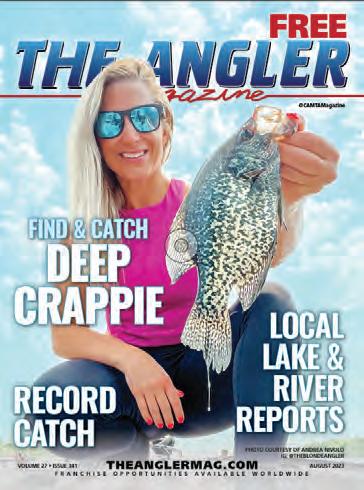












Suzuki Marine USA has unveiled its new Stealth Line™ of outboards for 2024, designed to provide boaters and anglers with a bold yet “stealthy” look that sets any boat apart from the crowd. The Stealth Line (“Shinobi” in Japanese) was introduced to boating enthusiasts, press, and the industry during today’s 2024 Miami International Boat Show, the largest recreational boating show in the world.
With a new, all matte black finish and matching Chrome Black graphics, Suzuki’s new Stealth Line delivers a look that compliments a range of popular boat styles, from bass boats, bay boats and flats skiffs to performance pontoon and deck boats to large offshore center consoles. With their “sneaky” good looks, this family of motors has a way of giving any boat an extra dose of attitude — whether sitting at the dock or racing across the water.
“The response we’ve already received from our dealers and boat building partners has been positive and powerful,” said Brandon Cerka, Suzuki Marine USA General Manager Sales and Marketing. “We know it’s going to be a big hit with customers across the country, especially within the serious fresh and saltwater anglers. With a Suzuki Stealth Line outboard on their transom, customers can dominate the water while catching plenty of envious looks from everyone,” added Cerka.
Underneath each of these motor’s bold exteriors lurks all the performance, advanced technology, fuel efficiency and rock-solid reliability boaters have come to expect from Suzuki 4-stroke outboards. Suzuki’s DF115B Stealth Line outboard is an inline 4-cylinder that delivers a powerful punch to flats skiffs, small center consoles, aluminum fishing boats and other popular vessels. The big block inline 4-cylinder DF150 and DF200 Stealth
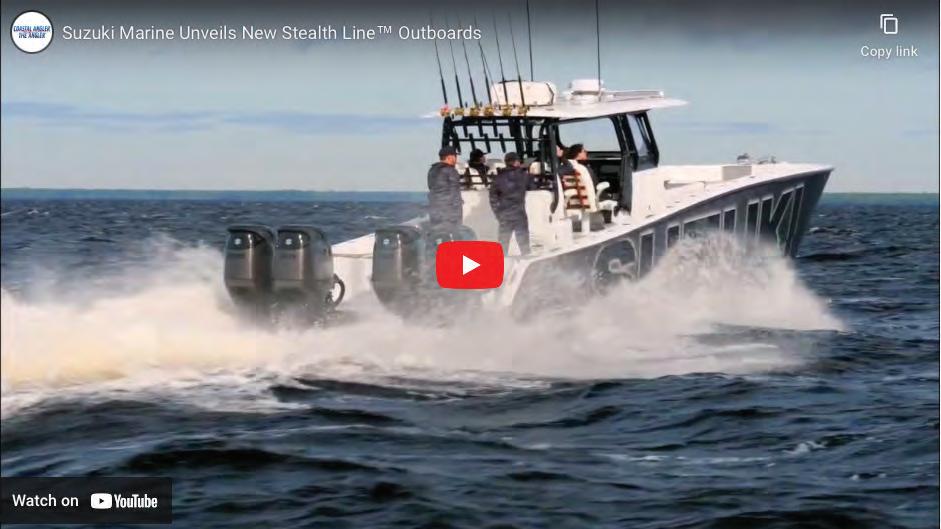
Line outboards are ideal for all applications including center consoles, bay boats and other freshwater/inshore boats that need to fish fast and hard all day long. Now offering a 2.5:1 gear ratio, these two Stealth Line outboards deliver serious power and fuel efficiency in a motor that is compact, lightweight, and of course, feature the eye-catching Stealth Line look.
Suzuki’s V6 Stealth Line includes the big-block DF250 Stealth (mechanically controlled), ideal for powering large bay boats, high-performance pontoons, and deck boats, as well as bass boats. Finally, the DF250A Stealth (digitally controlled) delivers the superior hole shot, strong acceleration and blistering top-end performance required to power premium high-performance bass rigs, walleye tournament boats and single application bay boats.
Suzuki Marine also unveiled the sleek and sexy Stealth Line concept version of its flagship V6 DF350AMD outboard, the industry’s first motor to provide the performance benefits and increased efficiency of dual contrarotating propellers. Suzuki will have future announcements on this model soon.
The DF115B and DF250A Stealth Line outboards are available now and the DF150, DF200, and DF250 Stealth Line outboards will be available early summer 2024. All the Stealth Line models can be purchased through authorized Suzuki Marine dealers across the United States. Check with your local dealer for availability.
To learn more about Suzuki’s new Stealth Line of outboards for 2024, visit your authorized Suzuki Marine dealer, contact Suzuki Marine’s Tampa, Florida headquarters at (813) 687-7200 or visit www.suzukimarine.com.

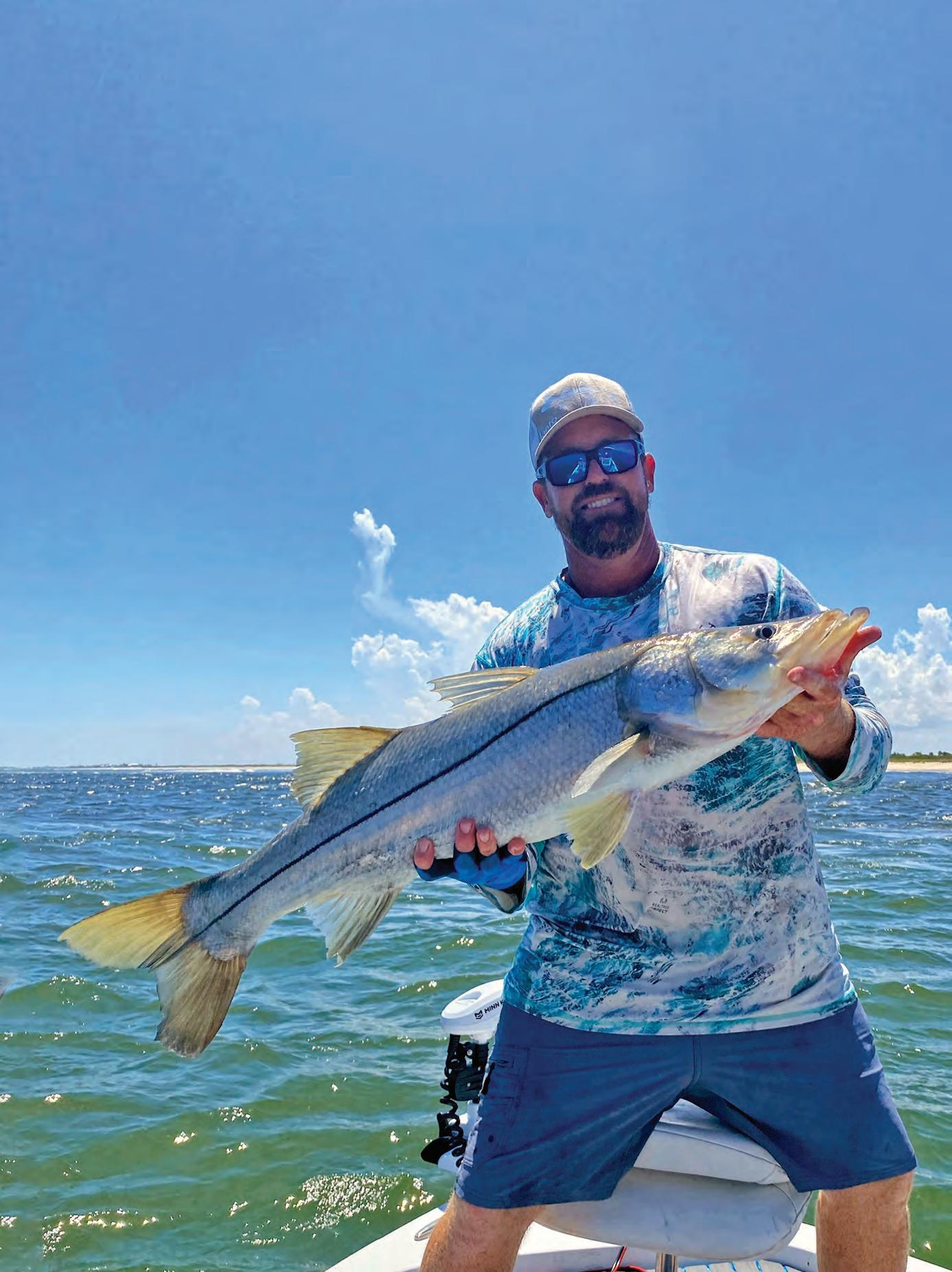

 By CAM Staff
By CAM Staff

Snook are hungry when they break out of the winter doldrums and go on the move this time of year. As spring temperatures begin to stabilize, they push progressively farther out of their backwater holes, and their migration intersects with the arrival of spring baitfish schools. It’s a recipe for an aggressive feed-up ahead of the summer spawn.
Snook fishing during this transition is very much dependent on the weather. A warming spell pushes snook out faster toward the passes and bays, while a cooling trend will slow them down. A cold snap will absolutely shut the bite down. If it breaks cold and clear the morning of your planned fishing trip, you’re better off targeting trout and reds.
While snook are moving out, big schools of scaled sardines and threadfin herring start to show up close to shore. These baitfish, also known as whitebait or pilchard and greenbacks, respectively, become the favorite food source for snook as well as many other gamefish. When water temps reach the mid-70s, a snook’s metabolism ramps up and they’ll eat anything from crabs and shrimp to mullet, but a lively sardine or herring freelined on a 2/0 circle hook is as close to a sure thing as you’re going to get. Generally, these baitfish are also pretty easy to find this time of year.

Where you find the bait is where you’ll find snook. Look at a map and draw a line between a known wintering hole and the passes where snook spawn in summer. In spring, they will be somewhere along this line, staged up and
feeding on structure. Snook are ambush predators and prefer to hang in the slack water while the tide sweeps food in front of them.
On the beginning of an incoming or outgoing tide, look to the docks, bridges, points, channel swings, mangroves, oyster bars and anything else that provides a little current shade adjacent to faster water. River mouths are a good place to start your search. If there are greenies or whitebait present, there’s a very good chance a school of snook will be there feeding on them. Want to know for sure? Use a chum bat to sling a double handful of disoriented greenies where you think snook might be. If they’re there, you’ll know it in a hurry.
Fresh live bait is the easiest way to catch fish, but the spring feed-up also provides lots of opportunity for anglers throwing artificials. If you’re someone who prefers to skip the hassle of catching and keeping bait, you can absolutely get the job done with a baitfish or shrimp imitation. Topwaters, soft-plastic paddletails, soft-plastic shrimp, twitchbaits, plugs and bucktails will all get bit. A couple benefits to artificials is you can use them to cover lots of water quickly to find fish and they can be skipped up under mangroves and docks.
For more tips and tactics, visit coastalanglermag.com.


Tampa Airport, it was hard for me to believe that in 30 years of traveling the planet to fish, Jimmy had never been to the British Virgin Islands (BVI). Of course, this was my first trip to the BVI as well, and filming with Jimmy is pretty much any angler’s dream come true. Getting to the BVI was pretty quick and easy, and once we arrived in Tortola the Film Commission and locals rolled out the red carpet for “America’s Favorite Fisherman” and me with a warm welcome.
Next stop: the Scrub Island Resort & Marina. Not to be outdone, Owner Gary Eng and Capt. Tommy LaRonge picked us up at the airport aboard the Ruckus, a Viking 61 we would be fishing on for the next three days. Ok, I am not going to lie. I am not used to the star treatment, but I could get to liking it pretty quickly. Pulling up to the resort, you realize even the beautiful photos can’t do it justice. Scrub Island is one of a kind… a bucket-list destination. After a great dinner while listening to the steel drum band, we all decided to head to our rooms knowing Capt. Tommy had big plans for the next day.
We had been watching the weather and knew it was going to be about 6 to 8 foot offshore with pretty high winds. But that was OK. As I told Jimmy, wahoo like it rough. That morning we were heading out to work the North Drop, which would consist of high-speed trolling about 13 knots back and forth across the 50to 100-fathom depth contour. World records are set on this drop, so you never know what is
FishBrain, so we were anxious to get the party started and give our followers something to see. About two hours into it, a reel started to scream. Three hundred yards of line were gone in an instant. This fish was a beast!


pounds. They had caught some African pompano a few days before, so we were hopeful they might show up as well.
Jimmy jumped into action, grabbed the rod and began battling his first wahoo. Anyone who has caught a wahoo knows they don’t come easy, and a beast this size was not going to give up without a fight. Jimmy was on this fish for about 45 minutes. As he got the wahoo close, an 8-foot hammerhead showed up at the back of the boat waiting for Jimmy to feed him lunch. It was a race against nature at this point, and Jimmy and the crew threw it into high gear. With gaffs in hand, Bo and Tommy waited for their only shot to get this monster into the boat before it was bitten in half. They nailed it! Both guys pulled the possible record wahoo over the rail.
The looks on everyone’s faces were priceless as we all realized this wahoo was easily bigger than 100 pounds. It took some doing, but somehow we fit Jimmy’s fish in the deck box and iced it down. Shortly after, I came in second with a respectable 42-pound wahoo, but of course it looked quite small next to Jimmy’s.
After taking a beating from rough seas for three hours, we decided to head inshore after yellowtail. We broke out the spinning rods, cut bait and got to fishing. Capt. Tommy had put us on the sweet spot because almost instantly we are reeling in some huge yellowtail snapper,
It became a contest. Every time I caught a big, healthy yellowtail, Jimmy would trump me with a bigger one. I learned pretty quickly that trying to out-fish Jimmy is impossible. I may be a decent fisherman, but Jimmy has been blessed with the gift of thinking like a fish. Toward the end of the day, Jodi, our cameraman’s wife, picked up a rod to try her hand at catching a few, and low and behold she caught my African pompano. She landed that fish like a pro and made sure she caught the only pompano of the day.
All in all at that spot, we caught and released nine different species of beautiful fish. Incredible. Keep an eye out for this episode, which will air on NBC Sports, JHL Network and Outdoor Channel.
It was a day of fishing Jimmy nor I will ever forget, for different reasons. Jimmy caught his first wahoo, and it was the fish of a lifetime. I was able to be there with him when it happened. On the way back in, Jimmy turned to me and said, “By the way, Misty, did you know that all the wahoo I have caught have been over 100 pounds?” He followed up with his famous laugh. Spoken like a true fisherman.
Misty Wells is an outdoor writer and host of “Let’s Take It Outside” TV and radio show. See her website at www.mistywells.com.









Prepare for exhilarating water adventures with Yamaha Boats' impressive 19 Foot Series. Featuring the Runabout lineup (SX190, AR190, SX195, AR195, and 195S) and the Center Console FSH Boats (190 FSH Sport and 195 FSH Sport), each group offers unique features tailored to specific preferences, ensuring an unforgettable experience for both family water sport enthusiasts and fishing anglers alike. Regardless of the model, consumers can look forward to Yamaha's award winning Connext® touchscreen technology, state of the art sound system, and bimini top available on every 19FT unit.
Known for their style and ease of ownership, The SX190 and AR190 boast a compact design without compromising performance. Equipped with the all-new 1.9-liter High Output Yamaha Marine engine, these boats provide a great blend of power and agility. The Connext® touchscreen technology provides easy access to navigation, entertainment, and other essential boat functions. Their compact
size and trailer allow them to fit into most garages, adding convenience to your boating experience.
The SX195, AR195, and 195S take the Runabout Boats to the next level. These models offer spacious seating for up to eight passengers, ensuring that everyone can join in on the excitement. The sound system guarantees a premium audio experience, elevating your time on the water and making every adventure feel like a party. While the Yamaha SX190 and SX195 are believed to be the perfect welcome to boating, watersport lovers will be drawn to the versatility that the tower provides on the AR190, AR195 and 195S models.
The FSH Boats, including the 190 FSH Sport and 195 FSH Sport, seamlessly combine fishing functionality with family fun. Designed with anglers in mind, these boats feature a center console layout, dedicated fishing amenities, and ample storage space for gear. The 190

FSH Sport and 195 FSH Sport come equipped with everything needed for successful fishing trips, including an 18-gallon livewell, T-Top rod storage, and casting platforms. But they are not just for anglers; these boats are versatile enough for the whole family to enjoy. With their innovative helm layout, spacious seating for up to eight passengers, and integrated swim platforms with tow hooks, you can relax, fish, and tube all in one vessel.
From the Runabout Boats’ advanced technology and garage-friendly size to the FSH Boats’ combination of fishing prowess and family-fun, Yamaha offers a boat for every adventurer. Embrace the thrill and make lasting memories with Yamaha Boats' 19 Foot Series. Whether you're a water sports enthusiast or a fishing aficionado, these boats are designed to exceed your expectations.
ExploreYamaha’s 2024 19FT Series at: www.yamahaboats.com



Maryland’s trophy striped bass season in Chesapeake Bay will be eliminated this spring by emergency regulations approved in February by the Maryland Department of Natural Resources.
The emergency regulations extend periods of closure to recreational striped bass fishing in the Maryland portion of the Chesapeake Bay. Targeting of striped bass will be prohibited from April 1 to May 15, eliminating the Maryland striped bass trophy season. In the Susquehanna Flats, targeting of striped bass is prohibited through the end of May.
The Chesapeake Bay is the primary spawning and nursery area for 70 to 90 percent of the striped bass of the Atlantic coast. The emergency regulation is aimed at protecting the mature fish that travel up the bay and return to the rivers where they hatched to spawn each spring.
Emergency regulations can take effect for 180 days; the state is also pursuing these regulation changes through its standard regulatory process, which could create regulations that would remain in place beyond 180 days.
These Maryland-specific actions complement additional coast-wide recreational and commercial measures set by the Atlantic States Marine Fisheries Commission (ASMFC). On January 25, ASMFC approved an addendum to the Interstate Fishery Management Plan for Atlantic Striped Bass that aims to reduce fishing mortality in 2024.
For the Chesapeake Bay recreational fishery, which includes charter boat fishing,
the addendum implements a 19inch to 24-inch slot limit and a bag limit of one fish per person, per day. For the ocean recreational fishery, the addendum implements a 28-inch to 31inch slot limit and a coastwide daily bag limit of one fish. For the commercial fishery, the addendum reduces commercial quotas by 7 percent in both the ocean and the Bay.


In addition to the approved emergency regulations, Maryland is considering establishing these rules permanently. The state is also considering extending the recreational and charter boat summer closure by an extra week, through Aug. 7, and closing the commercial hook-and-line season during the recreational and charter boat summer closure. Recreational anglers are currently prohibited from targeting striped bass in all waters of the Chesapeake Bay and its tidal tributaries from July 16 through July 31, the hottest part of summer when fish are most vulnerable to dying after being caught and released.
DNR officials encourage anglers to pursue other fish, such as blue catfish and northern snakehead, instead of striped bass. Blue catfish and snakeheads are invasive species and harvesting them contributes to a healthier ecosystem in the Bay.
The emergency regulations come into effect after five years of below average spawning success for striped bass. In 2023, Maryland’s annual striped bass young-of-year index, which tracks reproductive success, was 1.0, well below the long-term average of 11.1. Environmental conditions, including warm winters and low water flows, have been unfavorable for striped bass spawning and are considered to be factors behind the decreased spawning rates.

The full effects of the diminished spawns will likely become more apparent in the adult population of striped bass in the next few years, as the juveniles reach maturity and contribute to a lower abundance of legalsized fish. DNR biologists have emphasized the need to protect the spawning stock of striped bass in order to enhance the odds of a successful spawning when environmental conditions are favorable.
A comprehensive striped bass stock assessment scheduled to be released in 2024 will determine how the species has responded to previous management actions made by Maryland and other coastal states during the last few years.
For more information, visit Maryland’s striped bass webpage at https:// dnr.maryland.gov.







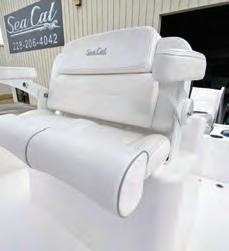
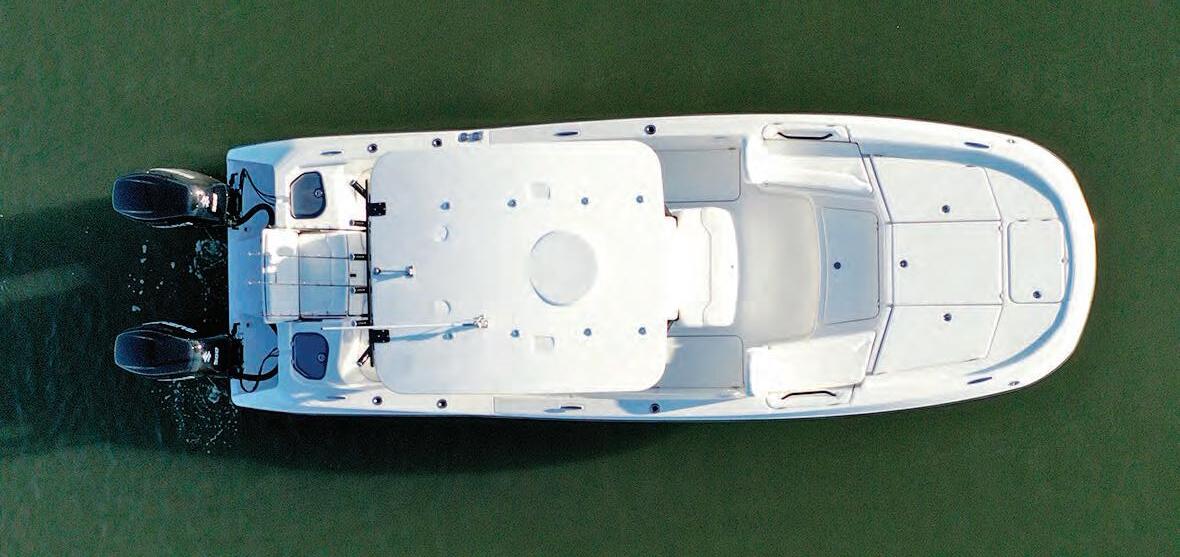

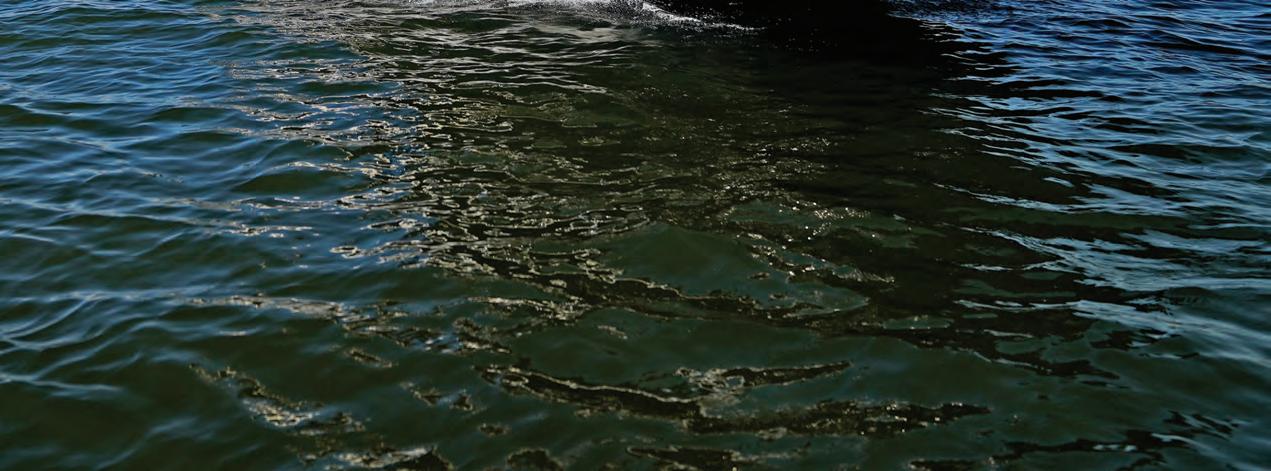


American shad are truly remarkable fish. They hatch in a river somewhere along the Atlantic coast of North America. From there, they hit the open ocean, take a hard left and head up toward Nova Scotia. They can go all the way to Nova Scotia, take a right, and then kick it out to 100 to 500-plus fathoms before returning south to the river of their birth.


Over northward and southward ocean migrations that can carry them 12,000 miles, they have the ultimate will to survive. I’m sure big rockfish and cod love a shad, and out deep they are prey for swordfish, sharks and everything else. Pound-for-pound, they are also one of the best sport fish of all. They pull hard right up until you lift them out of the water or dehook them. It’s much easier on the fish if you unhook them in the water.
American shad populations are in trouble due to overfishing, pollution, dam construction and other reasons in many of the river systems where they have historically spawned. Fishing regulations vary from state to state and river to river. Yet their spring runs remain gangbuster in some places. Check your state’s regulations before you head out in search of them.
There is an interesting book on the history of shad from colonial days to somewhat present. The name of the book is “The First Fish.” “Salt shad” at one time were traded as currency by the barrel, and were the staple food source for some regions. It tells how shad were protein in lean years during the colonial revolutionary period. They kept some coastal regions, in particular George Washington’s men, fed. It’s an interesting read for historical value, but from what I know there could be some expansion of reality. I’ll leave it at that.
I said all that to say this: The American Shad is a hard-fighting fish with a no-surrender attitude. They are so much fun on light tackle. The

first shad usually show up in rivers prior to Valentine’s Day, but the bite gets good in rivers of the Carolinas and Virginia in March.
A small double-tackle rig of lead-head jigs with soft plastics definitely gets the bite. As far as table fare, it’s not for everyone due to the bones. The flesh is delicious, but the bones are so small and intertwined that it takes an expert to debone them.
I like to keep one or two shad for bait, because wherever there’s a big stack of shad, there are other fish present to eat them. Catfish and striped bass come to mind right away. A nice fresh chunk of shad on the bottom or suspended off the bottom under a sliding cork will also get the bite.
The weather this time of year can be cold, or perfect, and everywhere in between. Bundle up, find a good run and get out to enjoy the “first fish.”
See more from Tim Barefoot at Barefootcatsandtackle.com.
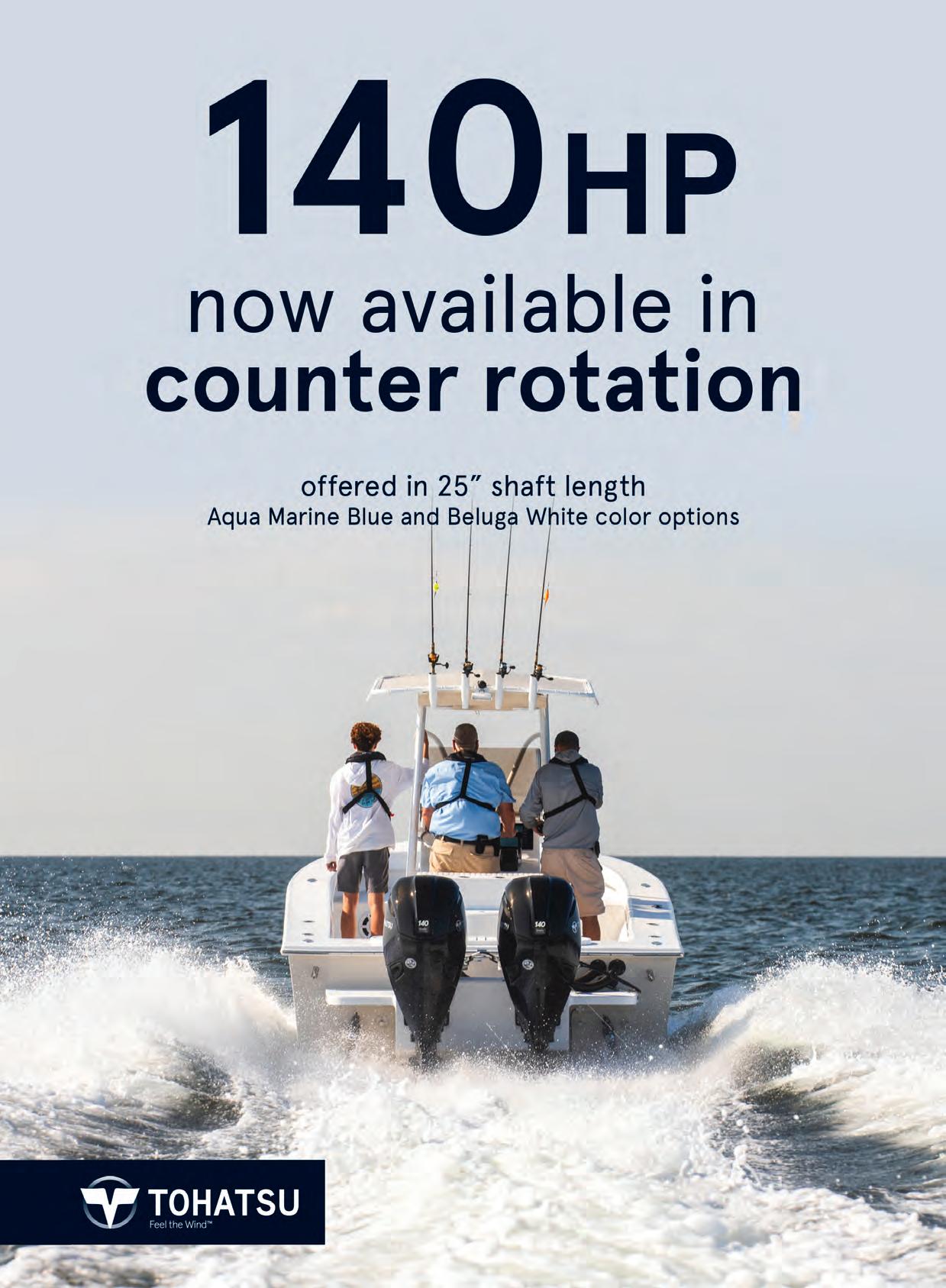






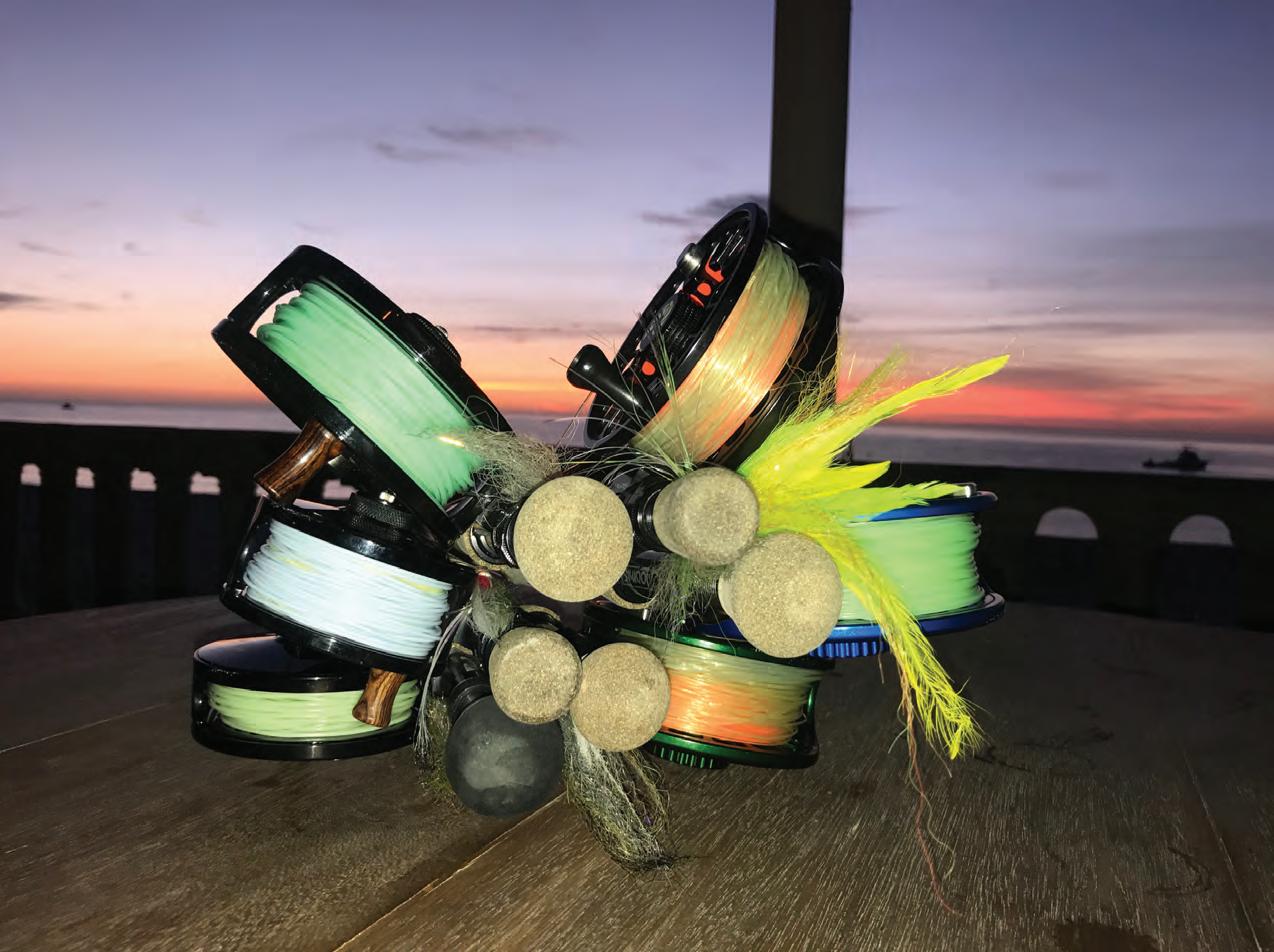 By Will Robinson
By Will Robinson
Choosing the right fly reel can really make your head spin. From basic drags to sealed-disk braking systems, the prices and quality vary dramatically. My gut always tells me to get the best that I can. Buy it once and you won’t be replacing it in a couple of years.
While this typically holds true for fly reels, there are instances when it can be overkill. If you are looking for an inshore 8-weight and will be typically chasing snook in the backcountry, the need for a reel with a silky smooth drag and 300 yards of backing is pointless. You will likely be fighting most fish within 50 feet of you. And much of the time, you’ll be hand-lining them and have no need for a fancy drag system. In these situations, the reel is more of a line holder and can be much less expensive than their highly tuned cousins.
A good starting point is deciding if you
need a sealed drag reel. They are nice, and most are very well made with super smooth drags, but that comes at a price. A great advantage of these reels is that they are virtually maintenance free. The sealed drag keeps water out, so rinse them down well after fishing and, you are pretty much done. The negative is they are typically higher-end reels and a bit pricey. For nearly two decades I have fished with non-sealed drags and have never had an issue, but I need to do a little more maintenance and cleaning on those reels. Also, if you primarily fish from a boat where dunking a reel is not likely, this could be a great way to save some dough.
Another important question is size, which often has to due with how much backing you think you will need. Since the tackle is lighter, it’s nice to have the line for long runs when fishing open areas, but again, if you typically fish tight spots there might not be a need for
300 yards of backing.
Conversely, if you are looking to chase large tarpon or go offshore, you need plenty of backing. Larger arbors are great, even with limited backing. They allow you to pick up line at a much faster pace, making life easier on both the fish and fisher. Finally, opt for ported reels, as they are lighter and allow your backing to dry much faster. This is important for the longevity of the line.
Smooth drags and plenty of backing are always nice. But be honest with yourself, this is an instance in which you can save a considerable amount of weight and money depending on the type of fishing you will be doing.
Will Robinson is a seasoned tournament angler and has been writing about fishing for more than two decades. His picks for the best reels can be found at Galvanflyreels.com and Nautilusreels.com.


It’s what’s under the surface that counts It is so much more than just bottom paint.
Interlux’s range of fouling control products not only improves your performance by protecting your hull from fouling, they also protect against the spread of invasive species, safeguarding your local waters when exploring new regions, therefore helping you make a difference by looking after the waters that have provided you with enjoyment and freedom for so many years.




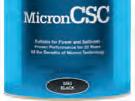
Like you, we have a passion for boating. We provide boaters the hull protection they deserve with over 140 years of cutting-edge science, technology and expertise. You can expect only the best from every Interlux yacht paint product, providing you the confidence to explore your world.
Relentless performance for every yacht, everywhere, every time.
international-yachtpaint.com

Hilton’s innovative SAT2NAV system connects your Garmin, Furuno or Raymarine chart plotters to HiltonsOffshore. com’s server directly from your MFD. Customize/download the latest dynamic charts and then navigate on them outside of cell range — ALL FROM YOUR MFD SCREEN!
Split screen a Hilton’s chlorophyll or sea temp chart along with a bathymetry chart and/or instrumentation.

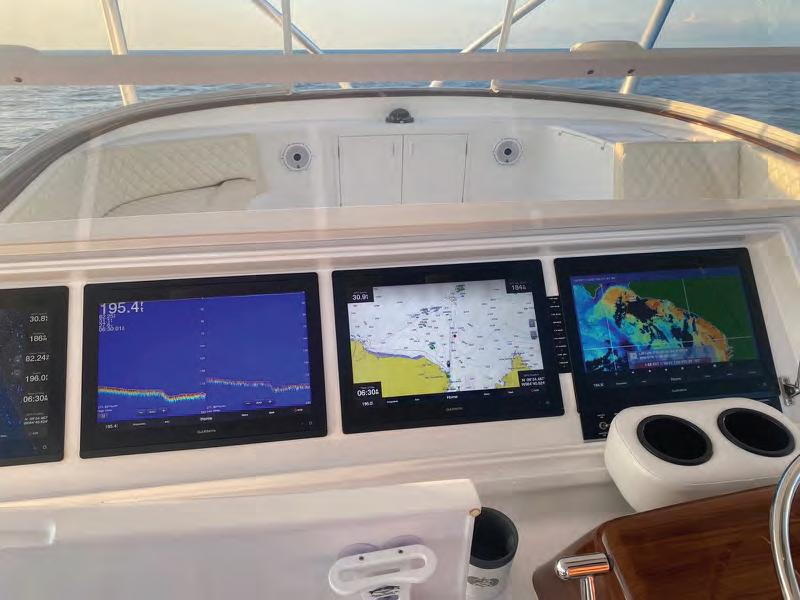

Since 2004, Hilton’s has helped serious offshore anglers catch more fish while burning less gas. This is the company that pioneered online satellite fish forecasting with timely updated charts that display all of the pertinent fishfinding information at a reasonable cost for the best anglers in the world.
This year, Hilton’s pushed the industry forward again with its SAT2NAV system. In a quantum leap ahead of any other service in the industry, Hilton’s has brought its unparalleled charts where they belong… to your boat’s chart plotter screen!
Gone are the days when a separate smart device was required to navigate on charts downloaded while in cell phone range. SAT2NAV allows you to surf Hilton’s online mapping portal, select desired charts and then navigate on them—all on the water and all from the multifunction display in your cockpit. Nobody in the industry can do what Hilton’s is doing with SAT2NAV.
SAT2NAV is an external device that connects to the monitors of your Garmin, Raymarine or Furuno multifunction displays. It has its own WIFI and GPS antennas and brings access to Hilton’s charts to the monitors at your helm. It is now possible view your vessel’s position relative to temperature breaks, color changes, high-res bathymetry, altimetry, etc. on your multifunction display.


With split-screen, all of this powerful imagery can be displayed alongside sonar, radar or other desired information. With SAT2NAV, it’s never been easier to identify and navigate to ocean features where bait and gamefish congregate. You can do your homework on the charts at home, but sometimes it’s necessary to call an audible on the water. With Hilton’s charts clearly visible on your monitor, you can find those good currents, minute temperature changes, sea-surface upwellings, color breaks and navigate to them. Perhaps more importantly, you can eliminate dead water, which makes you a much more efficient and effective angler. Of course, all of this comes with Hilton’s unrivaled service. Their philosophy, reputation and longevity in the industry rely on the concept that if the information doesn’t help you catch fish, you won’t use it. So, they continually strive to provide the best up-to-date imagery, information and technology, and they’ll go above and beyond to make sure you know what you’re looking at and how to use it.
Hilton’s, again, is leading the industry. With SAT2NAV they can do what no one else in the industry can do right now. At the same time, they are continually working to be better with additional eye-opening features that will further distinguish Hilton’s as the best in the fish forecasting industry. Stay tuned…


Sometimes called the “poor man’s giant trevally,” jack crevalle will strike a surface lure or bait aggressively, and once hooked, engage the angler in a slugfest they won’t soon forget. Jacks are world-class fighters.
These fish are perfect for small-boat anglers because they frequent inshore and nearshore waters. They can be caught in bays, inlets, canals and off reefs, where they target schooling baitfish. These fish are perfect for light spinning gear or a fly rod, as they will readily take any fast-retrieved bait imitation. They frequently show up in bays and estuaries following migratory baitfish like mullet. Strong current that concentrates bait is usually best, and you’ll find them at the mouths of the inlets on a strong outgoing tide. Any nearshore reef close to an inlet that has “nervous water” – a sure sign of bait schools—is prime territory for jacks.
A 7-foot medium-action spinning rod equipped with a 6000 sized spinning reel and spooled with 40-pound braid is a prime tool for fighting these fish. I like a fluorocarbon leader in the 50-pound range for abrasion resistance. These fish are not leader shy. Jacks school up in large groups of juvenile fish under 10 pounds. The larger 20-plus-pound fish usually hunt in pairs. While a 5000-class rod and reel setup will handle the smaller fish, a larger setup will be better for anything over 20 pounds.
Pro-Tip: If you tangle with one of the larger fish, get a second bait or lure in the water for a double hook-up!
Live bait and chum will usually find the biggest fish. Any local seasonal bait such as herring, pilchards, sardines or mullet will do the trick. For maximum fun factor, a topwater lure or fly stripped fast can’t be beat. I usually locate a school of feeding fish first then break out the fly or topwater spinning gear for sport.
A 9- or 10-weight fly rod setup with an intermediate line is optimal. When fly fishing, a popper, Deceiver, Clouser or any streamer pattern will work. I use flies that cast easily and in colorful patterns to attract the fish. With spinning gear, any noisy or splashy plug such as
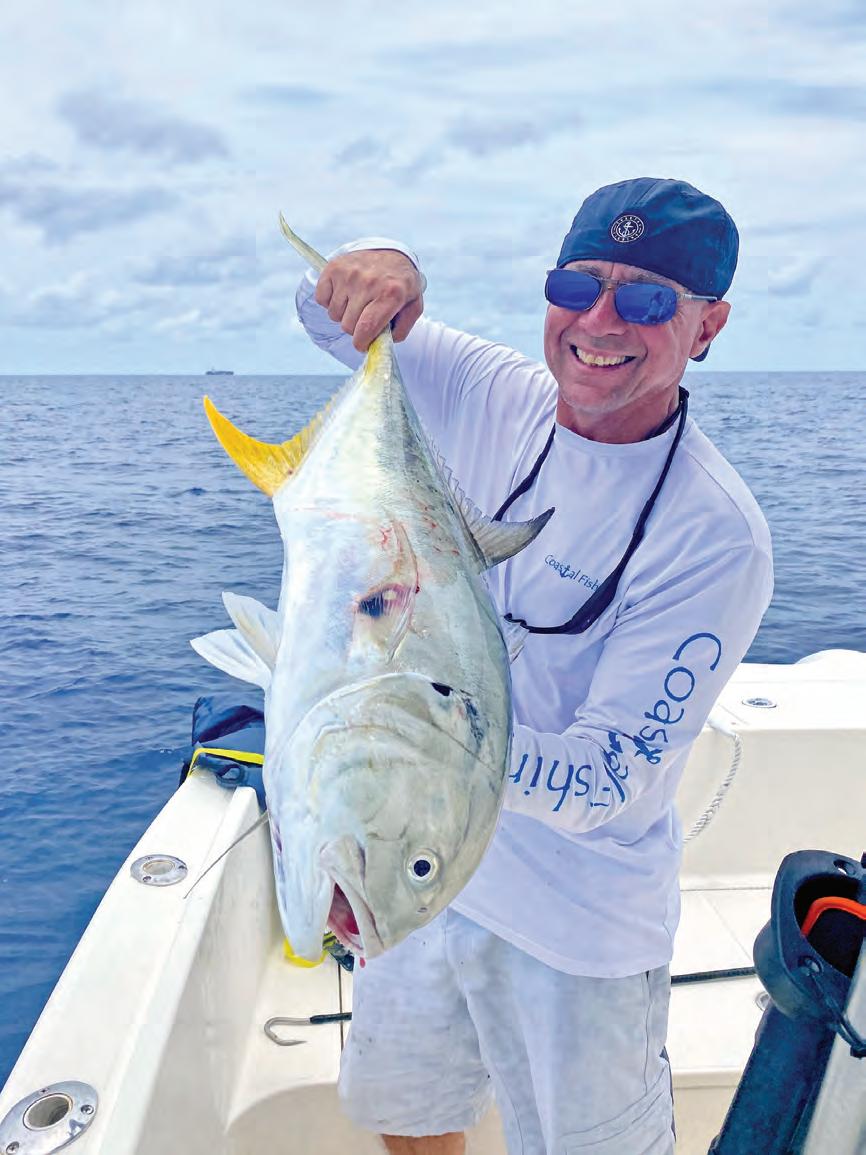

a 3- to 4-inch Storm Chug Bug is ideal. I also use a 4-inch Heddon Zara Spook in white with a walk-the-dog retrieve. Watching this lure get knocked out of the water and eaten is worth the price of admission. For sub-surface action, the Rapala X-Rap size 10 in Ghost finish can’t be beat.
The initial run of a big jack is spectacular, with ever shortened runs to follow. Using lighter gear, you might have to chase bigger fish down, so be prepared to move. Once a fish is spent, I usually use a net or tail grab the fish boatside for a quick picture and safe release, as these fish have limited food quality.
Now head out your local inlet and target these plentiful and eager sluggers. They will not disappoint.
Find Mark Ambert on Instagram @marksgonefishing_™; Email: marksgonefishing25@gmail.com.


Any angler that spends enough time on the water becomes hyper-sensitive to the performance they get from their gear. The new Find a Rod Builder section at BatsonEnterprises.com has made it easier than ever to get rods tailored for you, and built to fish your way.
Batson has combined the industry’s best line up of rod blanks and components with direct access to our network of professional rod builders that make awesome rods happen. Click to visit us online, browse rod blank and component options, and get in contact with the best fishing rod creators in the business.


The Chattahoochee Jig Company is based in north Georgia and specializes in crafting custom, handtied jigs for anglers. We ofer high-quality jigs that come in various styles and color combinations to enhance fishing success. Here are some of their notable products:
Chattahoochee PBJ: A versatile jig designed for effective fishing in local waters. Hand-tied with expert craftsmanship
Chattahoochee G.G. CHART Casting Jig: Another quality offering from the company, designed to attract fish with precision
Chattahoochee Pain Killer Casting Jig: Crafted with care and attention to detail, this jig is a reliable choice for anglers
Explore A full range of products, including jigs, shakey heads, and jig heads, on our website. Tight lines!
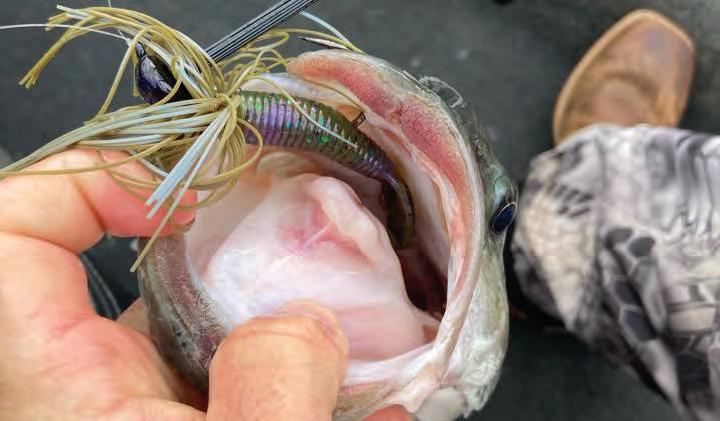
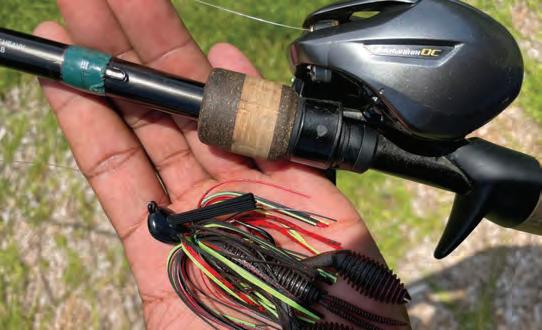


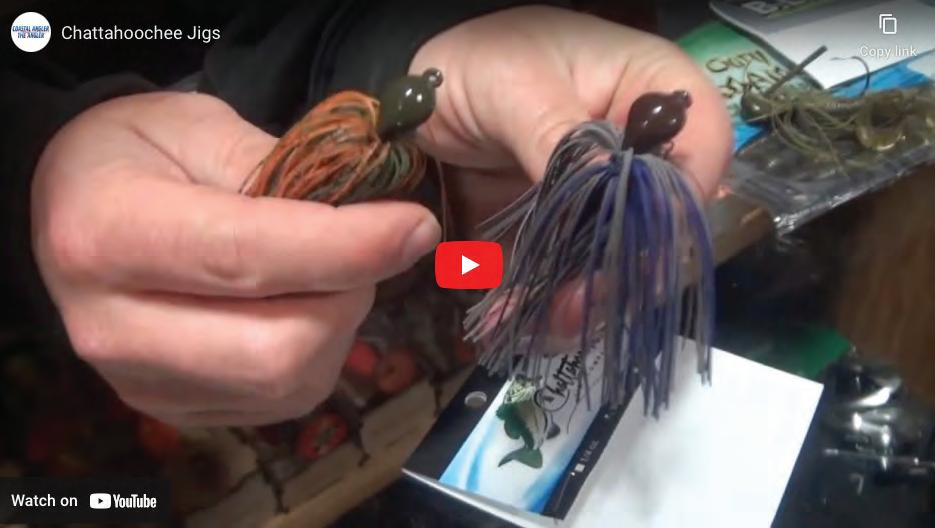

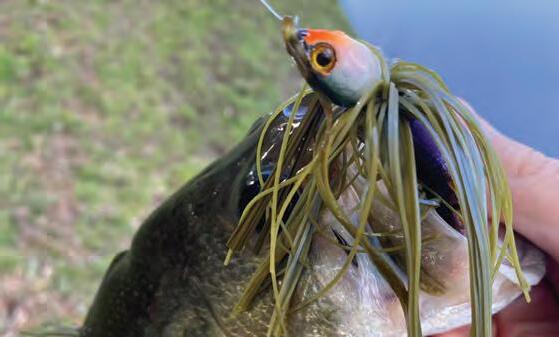





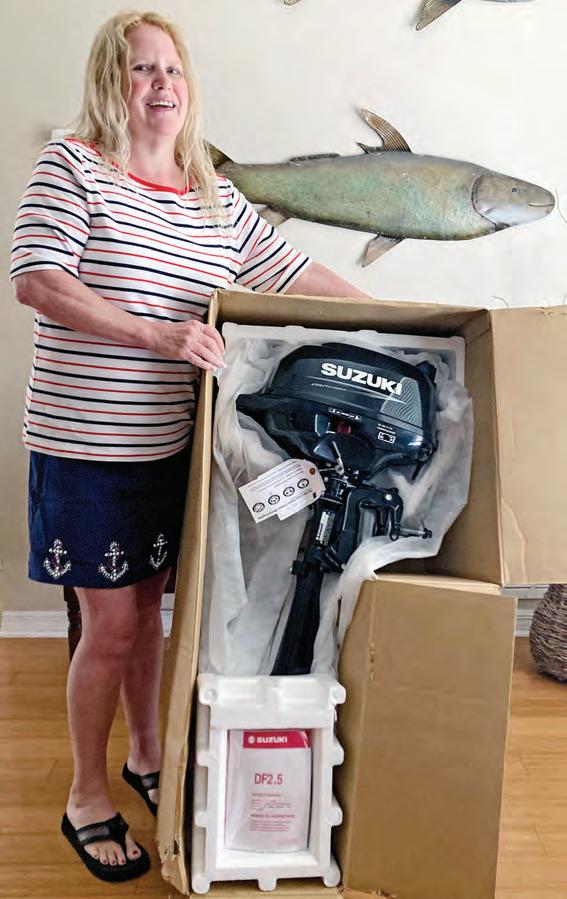
In December, Coastal Angler Magazine and Suzuki teamed up to award one lucky reader with an extra special Christmas gift as part of the magazine’s regular contest drawings. Jeanette Harkin, of Edgewater, Fla., is now the happy owner of small, but feature-rich Suzuki DF2.5 outboard, which she plans to use on the inshore fisheries around Smyrna Beach.
“I was super excited when I found out that I won, because we’ve been wanting to get a nice trolling motor for a long time,” Jeanette said. “It was an extra special Christmas present from you guys! Thank you again!!!”


The Suzuki DF 2.5 weighs just 30 pounds, and the smooth, quiet and dependable engine is a perfect fit for the 16-foot Gheenoe Jeanette plans to put it on. She goes out frequently after whitefish, redfish and blue crabs on the Intracoastal near her home, and this little rig will be perfect for zipping around on the flats and backwaters.
Coastal Angler’s current giveaway drawing is for two pairs of awesome Wiley X sunglasses. These high-performance and stylish glasses will be just in time for all your springtime outdoor adventures. Go to coastalanglermag.com, click the “Contest” tab, enter the drawing, and you could be sporting some free new shades on the water this spring.
To enter, go to coastalanglermag.com/contest.
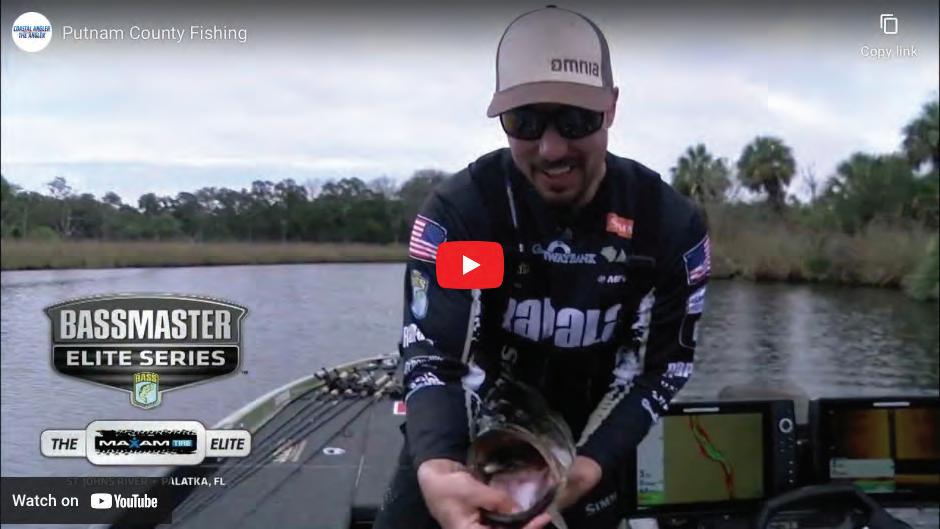
When the hubbub of the Bassmaster Elite Series descends on Palatka, Fla., April 18-21, anglers and fans alike will find a quality of fishing and a lifestyle that has made Putnam County an ideal destination for anyone seeking to experience the “Real Florida.”
Putnam County is the rural heart of North Florida, where the gorgeous St. Johns River flows northward between largely undeveloped banks as the centerpiece of the county’s abundant natural resources. It is a place where a high quality of life and nature’s bounty create opportunities for businesses and residents to thrive.

The St. Johns River is one of the most celebrated bass fisheries on the planet, and Putnam County has long been known as the “Bass Capital of the World.” It is home to three of the top 10 bass fisheries in Florida, according to the
Florida Wildlife Resources Commission, and bass are not the only game in town. The river and reservoirs hold some of the best fishing anywhere for many freshwater, brackish and saltwater species. While boasting natural shorelines and protected lands, Putnam’s waters are also accessible, with numerous public ramps and docks.
And fishing and boating aren’t the only ways to experience the region’s beauty. Putnam County is the “Trail Hub” of Northeast Florida. The Rails-to-Trails Project has an elaborate and expansive trail system through a picturesque mix of woods and rural landscapes. Hikers and cyclists will find plenty to explore, including the extraordinary topography of the “Ravine.”
Ravine Gardens is a formal garden with hiking trails in a steep ravine formed by the flow of the St. Johns. Azaleas and other exotic




species create a dramatic landscape, especially during peak flowering from late January to April. Outside of the formal gardens, the unique topography is enjoyed by hikers and cyclists by trail, and drivers can see it on the Ravine Loop Road. The whole area is an excellent place for bird watching.
Putnam County is ideal for anglers, and it is also a fantastic off-the-beaten-path place to kick back and relax in.

High
With the inflatable PaddleSki™ 437ps you can go 17 mph with a 6 hp outboard and motor 70 miles on just a 3 gallon tank of gas. That means this unique catamaran kayak can get to fishing spots that no other fishing kayak can! And when you get there, you can fish in ways no other fishing kayak can...stand up and cast with the sure knowledge that you are stable and safe or sit for hours fishing on the swivel seat enjoying 360° views in total comfort.


From fishing all day to camping all week, the inflatable Sea Eagle® PaddleSki 437ps catamaran kayak is a uniquely designed craft that can get you out on the water in minutes. This 14’ inflatable is a great option for 1 or 2 people looking to go far and to get into the shallow areas other boats and kayaks can’t. With a 6 hp gas motor capacity and the need for just about 12” of draft with a motor (2-3” of draft without), you can follow the fish from deep bays to inland marshes.
The PaddleSki has a high pressure drop-stitch floor that inflates up to 10psi providing you with a solid, stable standing platform for fishing, paddling or taking photos. The floor is supported by two large tubes that provide stability and keep the floor 4” above the water line which greatly reduces drag. And less drag = faster motoring & paddling speeds. Speaking of speed, with a 5 hp motor, the 437ps can reach up to 16 mph with 1 adult or 14 mph with 2 adults.
panel, you can fish indefinitely! Take a long weekend fishing trip and never have to worry about filling up the tank.
Since Sea Eagle® has been making inflatables for more than 5 decades, they know what they’re doing and they hit it out of the park when it came to the PaddleSki™ 437ps. It easily packs down to fit into a car trunk, RV, or truck
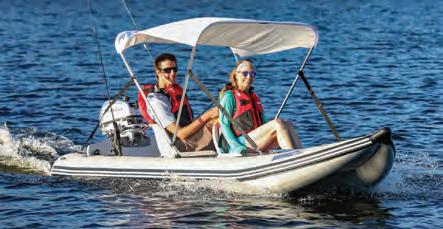
Did we mention you could stay out all day? A 3 gallon tank of gas will last about 70 miles. If you’re using an electric motor with a solar
bed, inflates in just 10 minutes to a full 14’4” x 48”, holds 2 people or 855 lbs. of people and gear, folds down to just 36” x 21” x 12”, it has 5 separate air chambers for superior safety, it’s made of 1000 denier reinforced PVC for utmost toughness, and it weighs just 58 lbs. (68 lbs. with the removable transom).
If you’re looking for a fishing boat that you can take on the road or just have limited space at home, the PaddleSki 437ps is for you. Check it out at SeaEagle.com.





It is always important to pay attention to our surroundings as we go through life, and fishing is no exception. How many of you have been fishing without any action and find yourself daydreaming and going through the motions until you feel the tug on your line? Suddenly you are frantically trying to remember the cadence of your retrieve to duplicate the action, but you are dreaming of fish instead of trying to catch them.
Well, in this article and the accompanying video for The Angler Video Magazine, I will go over a specific situation when paying attention paid off, and you can see it and hear me talk through it on the video. I will also share some wisdom from two incredible Texas guides whom I was fortunate enough to spend a few hours with on the topic of targeting big trout.
While wading in knee-deep water that was about 61 degrees, I could see a few mullet
jumping in their casual mullet way. It was enough to keep me interested in the area. The bottom had undulating depth with grass and scattered potholes, or sand pockets for those not familiar with the term. I was throwing a slowsinking soft-plastic jerkbait, letting it slowly sink between twitches where the sand and grass met.
With a cast in mid-air, I saw a mullet do an abnormal flip. It was distinct from the norm of the day and not as if it were being chased, but different, nonetheless. I burned my lure back in and made a cast just beyond where the mullet flipped. When my lure paused near the area, a nice redfish slammed my soft plastic. Had I not been paying attention and blew it off as just another mullet jumping, I would not have caught that fish and a few more in the general area.
Since we cannot always have a bird’s eye view,
By Capt. Michael Okruhlikwe need to utilize the birds’ eyes. Here are a few tips I picked up on during a conversation with guides. Birds do not always need to be feeding to point us to fish. There are subtle hints, such as a head turn of a gliding pelican. They don’t turn their head for no reason; they saw something. Maybe they saw a huge trout and kept soaring because it was too big for them to eat. Also, watch the lines birds are relating too. They may not dive, bait may not flee from the shadow, but they are flying that line for a reason, and maybe you should work your way toward the area.
Pay attention on the water and in conversation with old salts. You might need to read between the lines, but the answers are there.
Capt. Michael Okruhlik is the inventor of Knockin Tail Lures®, and the owner of www.MyCoastOutdoors.com.
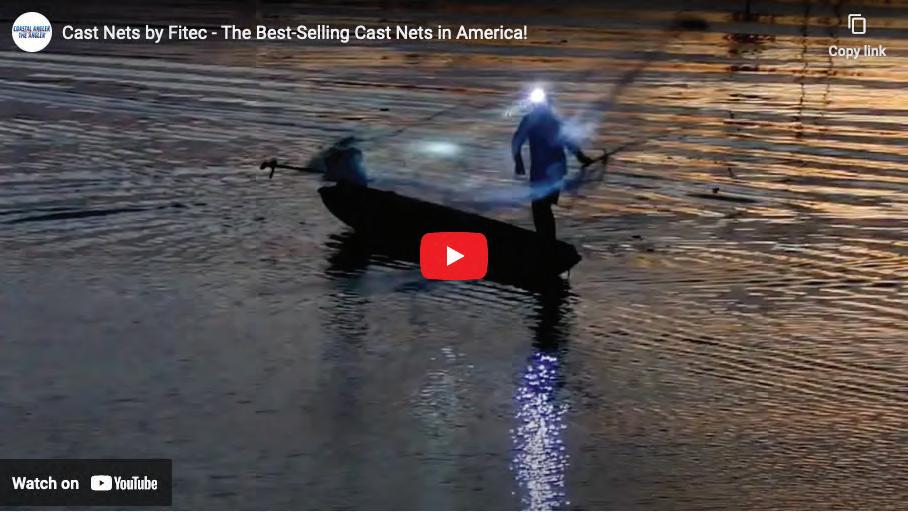



Experienced boaters know that even a tiny bit of air in a vessel’s hydraulic steering system can compromise performance, response and steering effort. However, the process of correctly bleeding the system— whether performing maintenance or installing new hydraulic steering on a boat—could be messy and challenging to do correctly. Not to mention that it is a two-person job, with one at the helm and one back at the steering cylinder.

Marine steering leader Dometic has forever solved this problem with its Power Purge Jr., a self-contained system that makes it easy for one person to fill and bleed 100 percent of the air out of any SeaStar hydraulic steering system in 10 minutes or less.
This system comes in its own sturdy carrying case and includes a blue helm hose, clear cylinder hose, helm adapter and battery connectors. All that’s required from the boater
is a wrench to open the bleeder valves and 5 quarts of SeaStar hydraulic fluid.
This system uses the boat’s battery power to quickly fill the entire system with fluid and fully remove even the smallest air bubbles— helping boaters get back on the water fast.
WWW.DOMETIC.COM




The easy way to 100% purge air out of BayStar and SeaStar hydraulic steering systems. Reduce installation and warranty costs while enhancing the quality of the boat to the end user. A typical manual fill and purge takes the average experienced installer or service technician about 30 minutes per boat – by using the Dometic Power Purge Jr. this can be reduced to 10 minutes or less.
www.dometic.com


Iwent fishing while on Florida vacation about a decade ago. After returning home to Canada for two months, I drove back to pursue a career in the industry. I had zero experience, no connections, and less than half a clue on where to begin. For those with a similar dream, here’s what I learned.
First, it doesn’t matter how long you’ve been a weekend warrior. If you want to be a captain, be a deckhand first. You don’t know what you don’t know, and working for someone fishing the waters you plan to guide provides all kinds of information. Every
fishery has its own etiquette and unspoken guidelines. Community is crucial, and paying your dues and earning respect goes a long way. Captains communicate about fishing on the water, and often, we are each other’s first responders. This same-team mentality is nearly currency.
Beginning as a deckhand is difficult. Nobody wants to train you, yet you must be trainable. On your own time, practice skills like knot tying, bait rigging and net throwing. Veteran fishermen are usually happy to flex knowledge to those who ask for help humbly.

No matter what you learn, be ready to have a captain you work for tell you it’s wrong. Adapt, and learn things their way.
The expectations of deckhands are high, and everything on board will be their fault. You are expected to arrive early, stay late, come in on days off, anticipate your captain and clients wants, and do it on minimum salary.
The biggest issue with new deckhands is they sometimes don’t show up. Finding a replacement at 6 a.m. is nearly impossible, and it affects the productivity of a charter. Being a
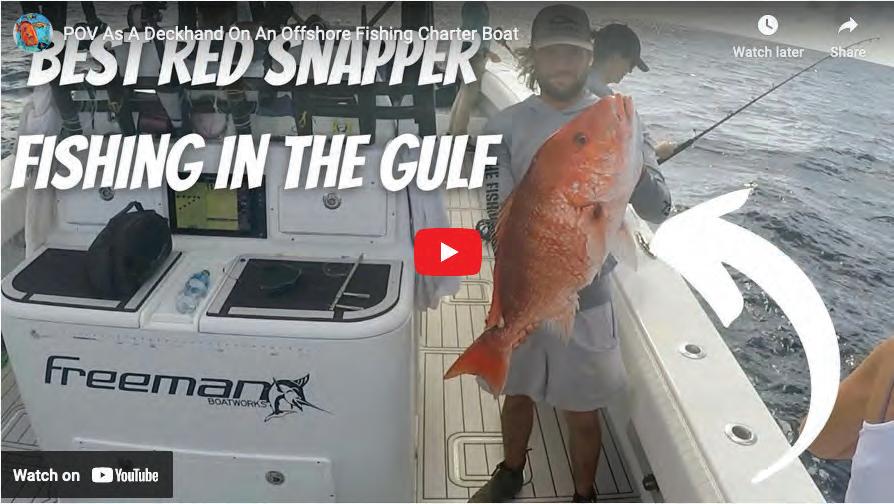

fisherman takes a special kind of person. If can fish six days a week and still want to go out for fun on your day off, this job may be for you. If you’re on the boat watching the clock, you won’t last long.
Showing up to the dock consistently is a great way to make connections and get work. If you can’t find work, show up an hour before local charters head out. Walk the dock and ask if anyone had a no-show deckhand. If you do this consistently and pass out your number, eventually someone will call you. They will see you have the dedication to show up. Deckhands are also required to be on a drug consortium. Sign up and keep your paper with you.
Lastly, if you hold a captain’s license and are working as a deckhand, make sure your “captain” has one too. You do not want to be held liable for someone else’s mistakes. Protect your future in the industry.
If this is something you want to do, I highly recommend going for it. In 10 years, I have never regretted it or lost the smile it puts on my face.
Capt. Quinlyn Haddon guides with Sweet E’Nuf Charters, Marathon, Florida Keys. Captainquinlyn.com; @captainquinlyn; (504) 920-6342.

Doe River


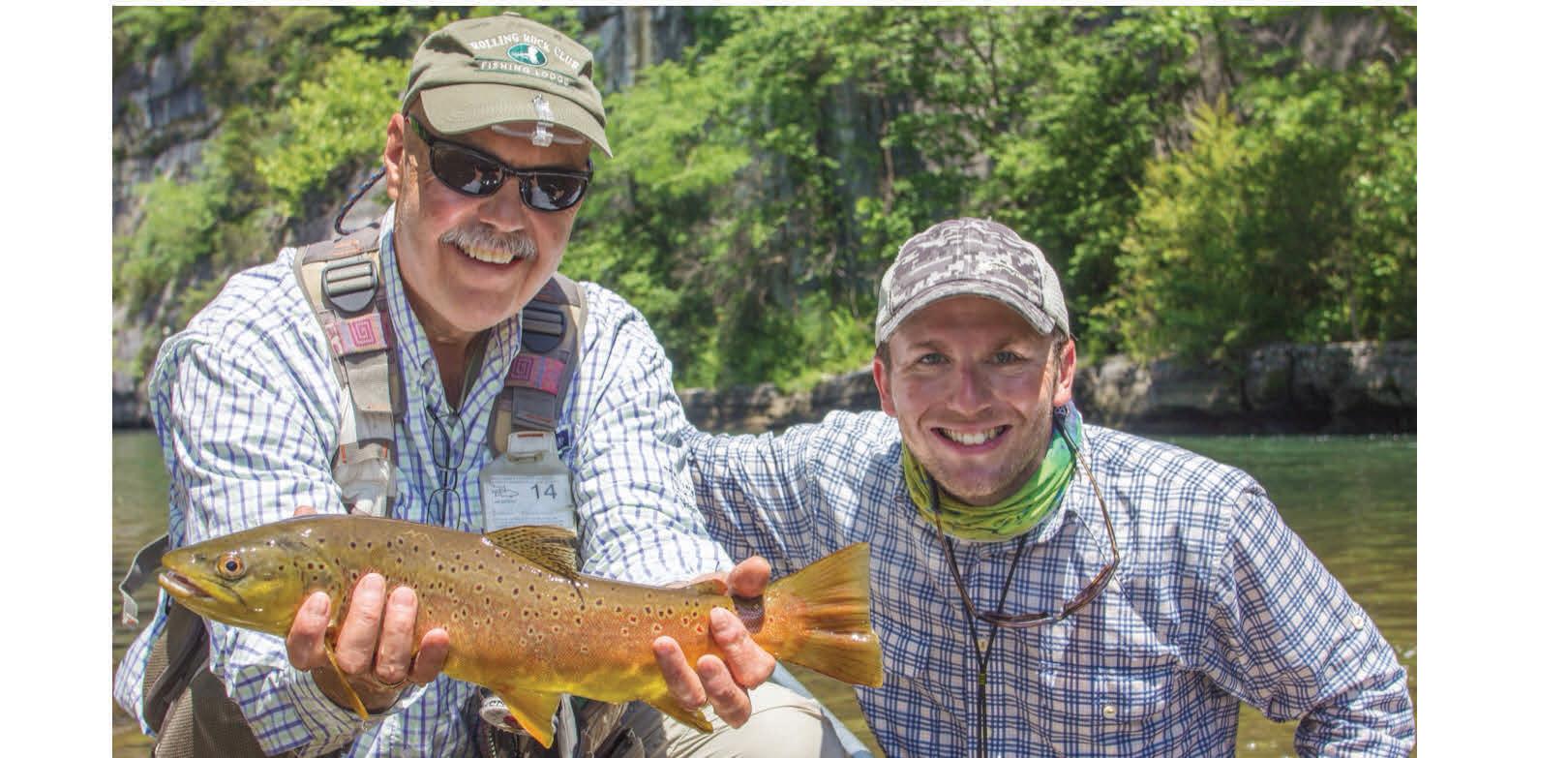







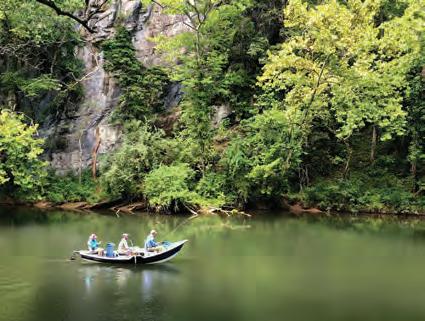








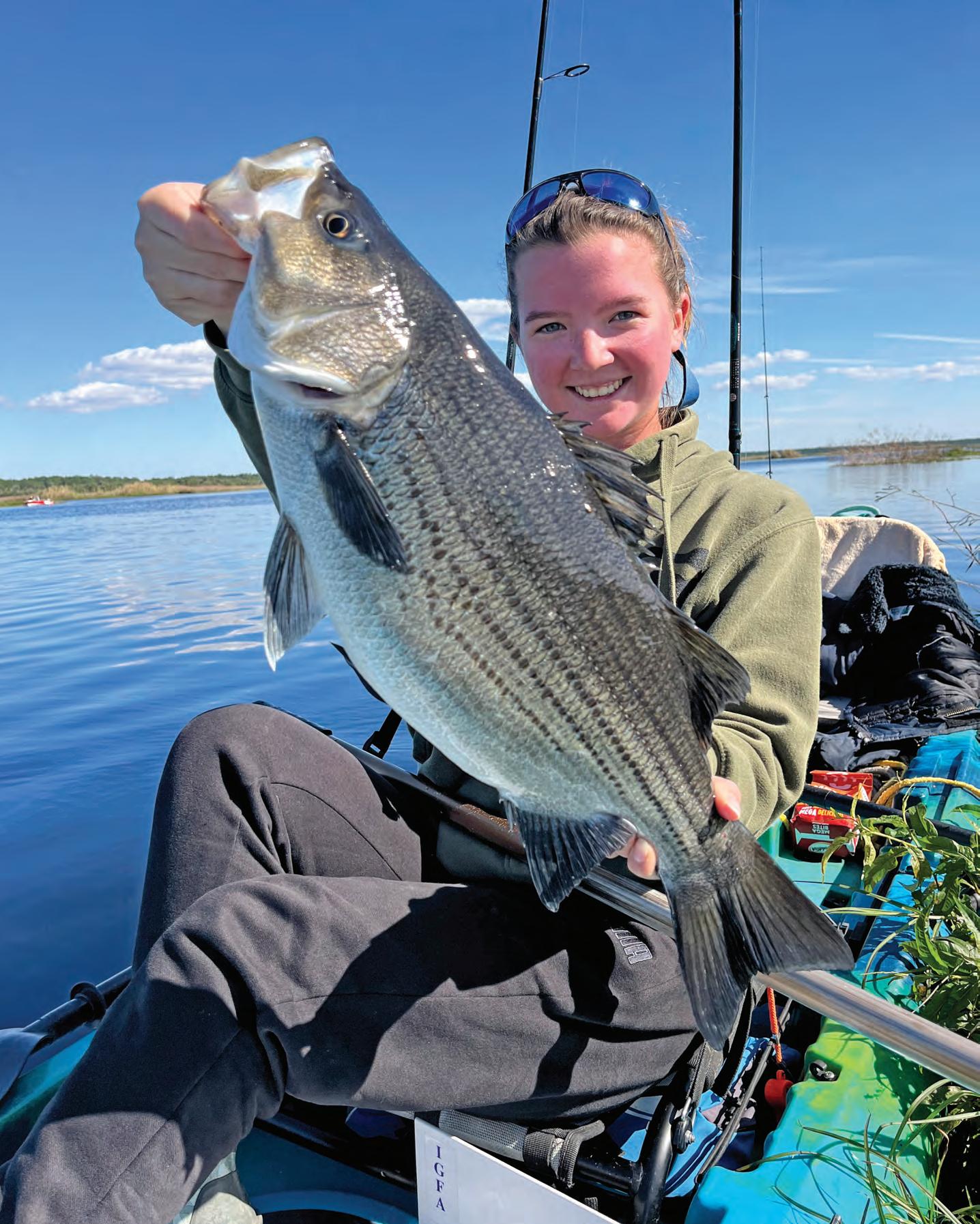

If you’ve read my column, you know that catching IGFA record fish is what I love to do. I’ve caught more than 60 of them, and people frequently ask which is my favorite. It’s tough to pick, but the following recent record is at the top.
Every year, just after the New Year, American shad move from the northern states south. This year, my dad and I went to central Florida to see if we could find some shad making their way up a river. Unfortunately, after hours of constant jigging with light tackle and tiny jigs and a couple miles of paddling a tandem kayak, the shad were a bust. We decided to take a lunch break with lines out for a catfish or bowfin. We soaked baits for about an hour without even a nibble. At this point, I was more than a little disappointed after driving three hours without even a bite to show for it.
Don’t get me wrong, the scenery was beautiful, but I was determined to catch
something! I started jigging again as my dad slowly paddled us back to the truck. About a quarter of the way back, I got a bite, a cute little 10-inch largemouth. Despite the size, I was satisfied; I had beaten the skunk.
I continued jigging until we were about halfway back, where this narrow part of the river opened wider. I made a “last cast” and had decided to call it quits. As I cranked my jig straight in, I was surprised when it got thumped! I laughed and told my dad we had been doing it wrong all day. To test the theory, I tossed my jig out and again just cranked it in. About two feet from the kayak, a huge swirl appeared where my jig was, and 4-pound line started ripping off my ultralight.
My dad paddled to keep the fish a manageable distance from the kayak while also maneuvering defensively to place the kayak between the fish and the vegetation. After an extremely stressful nearly 20-minute fight, we netted a beautiful, 7-pound-plus
By Emily HanzlikFlorida sunshine bass. I frantically checked the FWC website for the state record, which weighed 16 pounds, 3 ounces. However, I knew I had one more hope for a record. I checked IGFA and was more than pleased to find the women’s 4-pound-test record was a 5-pound fish. If approved, this will be my first record that was not targeted.
When you’re hunting records, it’s key to be prepared. No matter where we go, I keep my certified Rapala scale and my tape measure in a glasses container in whatever bag we have that day. The other key is to make sure you always have accurate line on your reel. I use tournament Ande line so I don’t have to worry about my line over-testing. Other than that, it’s just the luck of getting that big one.
Emily Rose Hanzlik has caught more than 60 IGFA world records in various categories. Find her on social media @emilyhanzlikoutdoors.
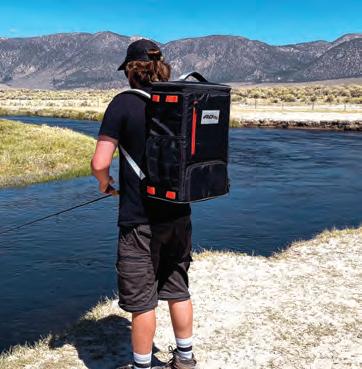
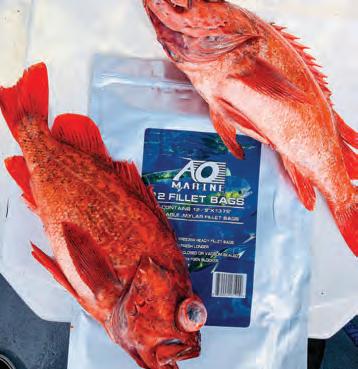





COOLERS, the leader in high-performance soft-sided coolers, is hitting the water this year with new, upgraded fishing products. Our fishing team partners told us what they needed, and we listened!
Products are in stock and ready to ship; The Fishing Cooler Backpack, 2, 4 & 6ft Fish bags, Fillet bags, Boat fenders, EVA Traction pads, Inflatable Docks, ISUPs, and of course, our high-performance coolers specifically designed for use on boats, guaranteed not to leak, and to keep ice cold for up to 24 hours.
Thirty years ago, AO was launched to provide active, hard-core people with quality products at a reasonable price. We started selling our soft-sided coolers to the hard-core, go-fast boaters and fishermen in Lake Havasu. We aimed to keep ice in our coolers for up to 24 hours in 120-degree Havasu heat. That goal was accomplished 30 years ago, and we’re still at it.
We know our customers; they fish and boat in the summer and ride the dunes or trails in the winter. AO products give those high-octane souls greater freedom to embark on and enjoy what’s important to them.
Make sure that your gear does not hold you back from doing what you love. AO products are built to handle whatever offshore adventure is coming next.
AO is flexibly rugged, seriously fun, and honestly real!
We’re looking for active, adventurous folks that demand quality and performance from their gear. Share your adventure and send us your fish story or photo.







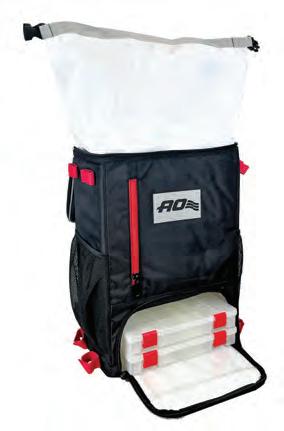

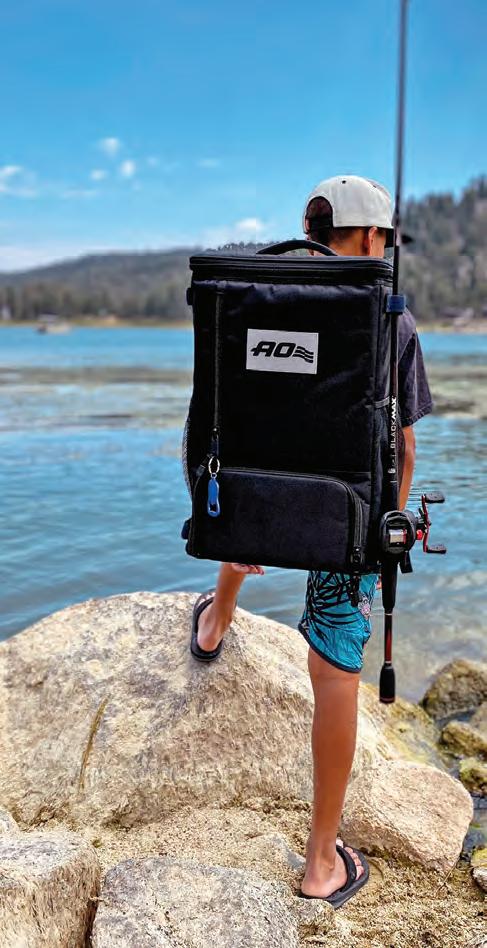





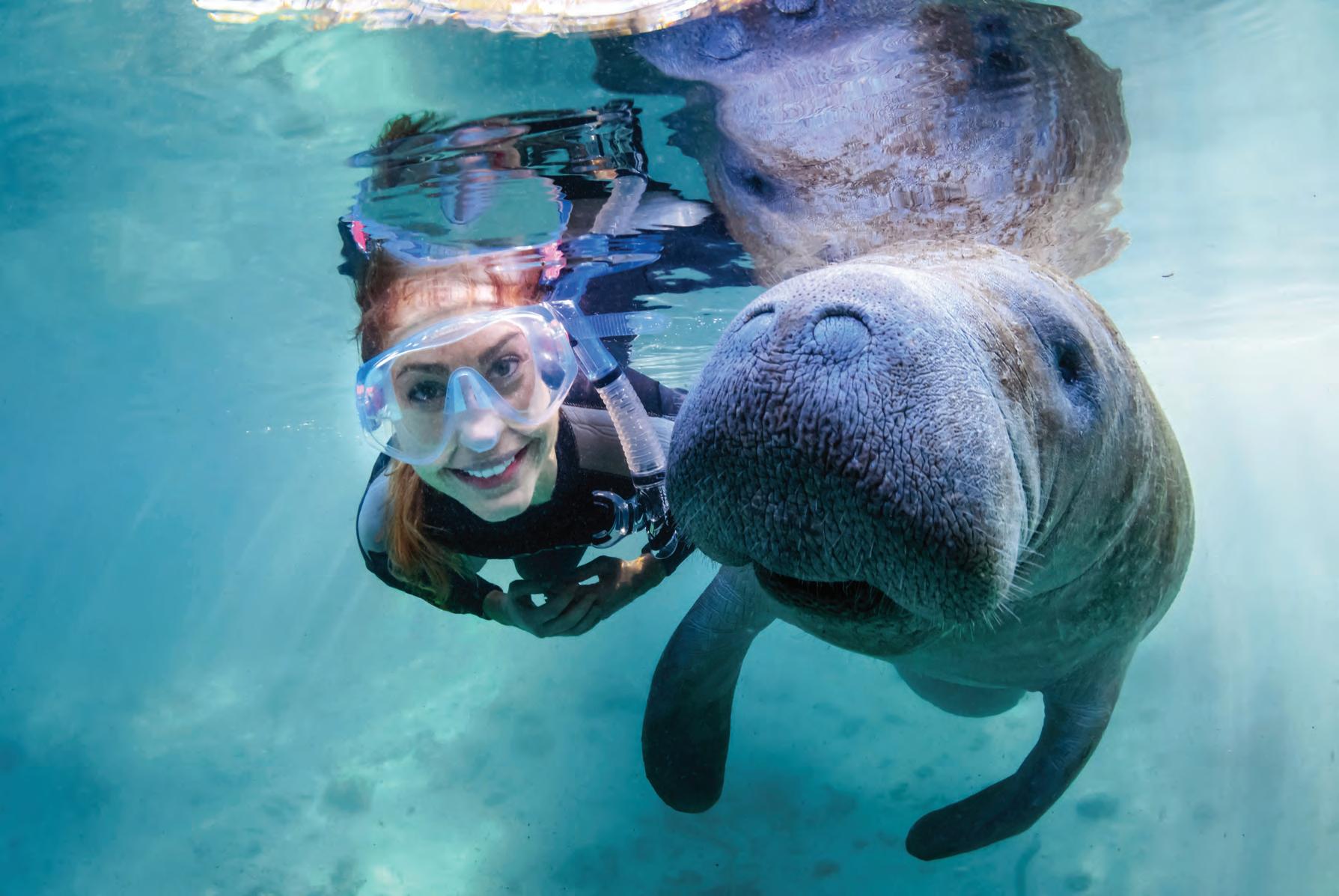
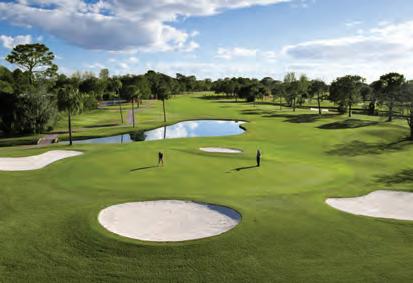








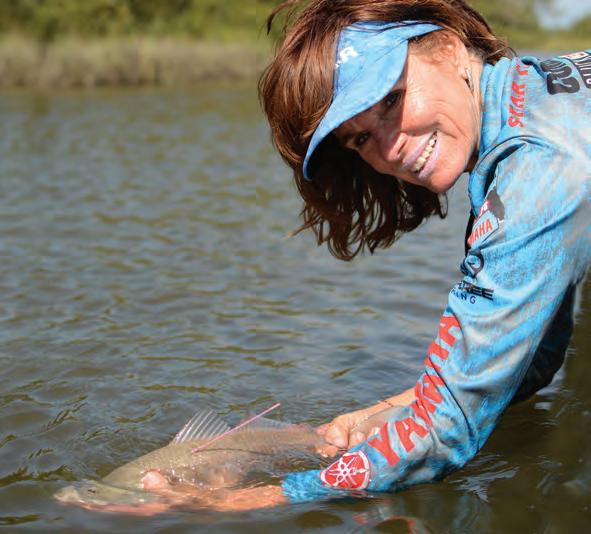


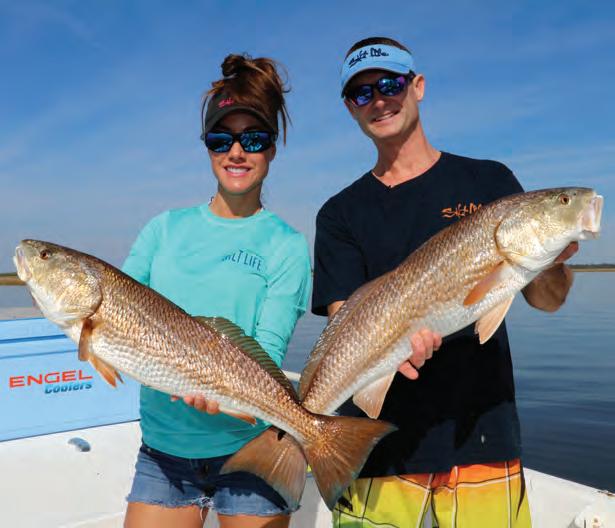
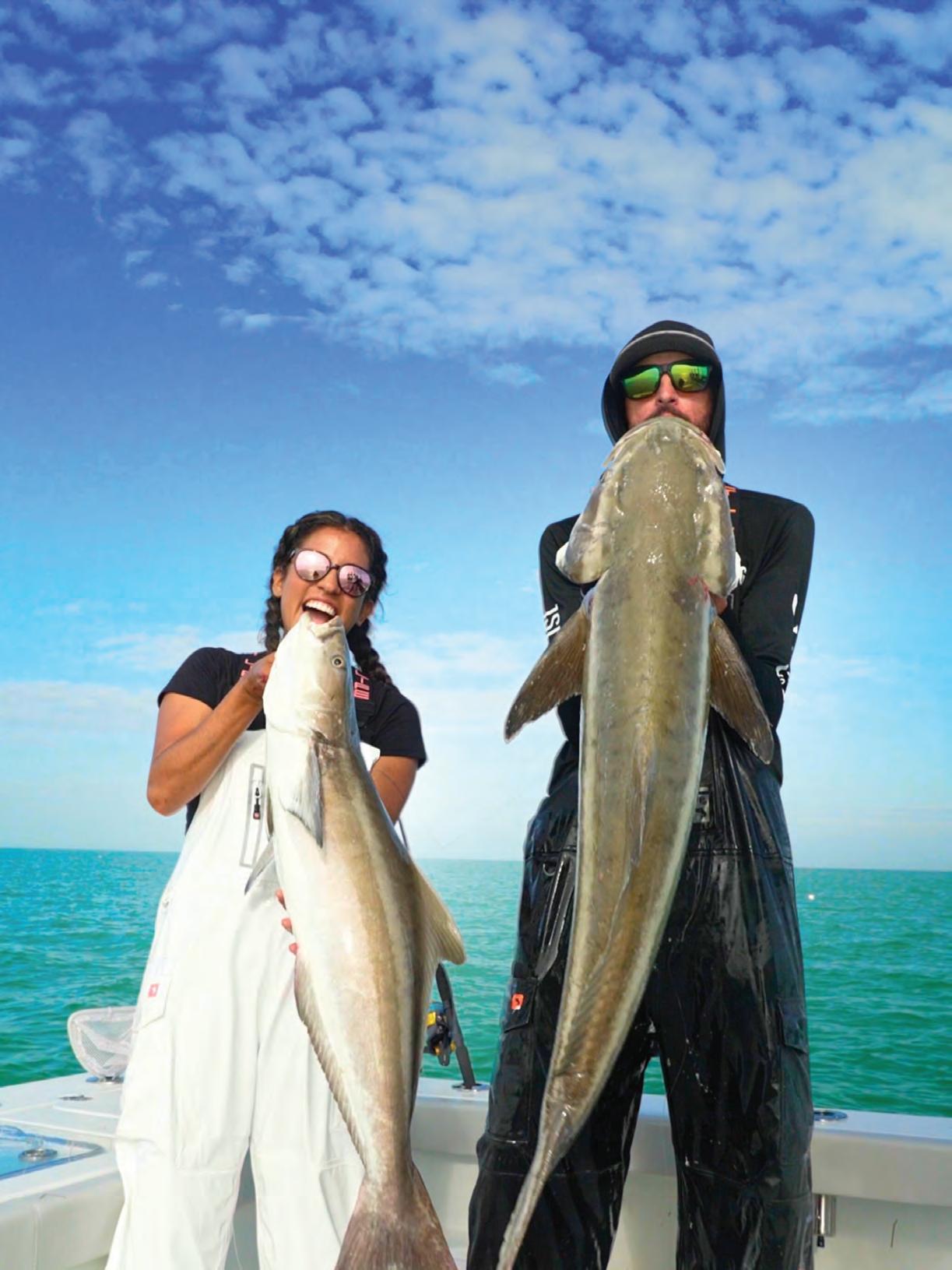

Cobia are robust, daring, and always up for a challenge. You know you’re in for some fun when you spot them cruising near the surface, sometimes in pairs or groups, hounding baitfish like a wolfpack or drawn in by curiosity at the action around your boat. If you’re geared up and ready for them, a little finesse will have you luring them in like a pro.
Location is key. When fishing for cobia in the backcountry here in the Florida Keys, we look for them to be around structures, wrecks and floating debris, often roaming the same areas in groups. They’re not pickiest eaters. Pitch a live bait out in front of them, and they’ll usually eat it, and we’ve also had great success with a Savage Gear RTF 3D Shrimp.
The action when using these Savage Gear


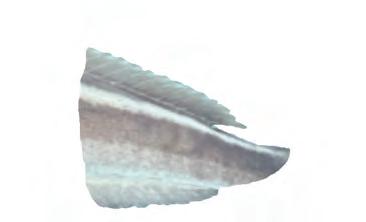
shrimps is a hard jerking lift, then letting your shrimp fall, mimicking a shrimp’s natural actions. For the battle, the optimal gear is at least a 4500 reel, but you really don’t need more than a 6500, and we always trust our Penn Authority and pair it with a medium/mediumlight Carnage III Rod for maximum control and power.
The most important thing to remember when hooking a cobia is to be ready, as it’s very common to spot “following” cobia. They often travel together and like to investigate what your hooked cobia is doing and eating. These “followers” can lead to an epic double header, but only if you have enough rods rigged and ready on the boat and hands to cast them.
Cobia are known for powerful runs, often scoping up and switching directions in a split second. Keep calm, adjust your drag, and let them exhaust themselves. Stay alert as you reel
in your cobia, as they are known for sudden maneuvers, and will sometimes dart under the boat in a heartbeat. And the fight doesn’t end even after you’ve gaffed a cobia. Exercise caution when you bring them over the rail and onto the deck because they often cause havoc on the boat. It’s best to tire them out completely during the fight to minimize potential damage.
Since FWC regulations frequently change with cobia, staying informed is important. One keeper cobia can feed a lot of people. Their meat is known for its steaklike texture and delicate flavor, perfect for a mouthwatering sear with butter and seasoning.
For the best shot at spotting a cobia, consider booking a full-

day charter. This helps your chances to see one, and the timing should be pretty solid for in the upcoming weeks.
Book a charter at www.beansportfishing.com and follow their cobia adventures on “Bean Sportfishing TV” on YouTube.














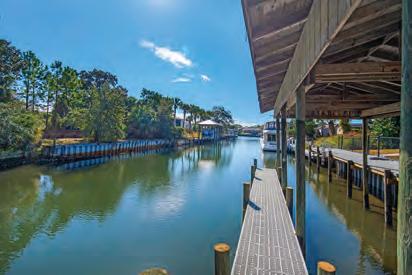

Be it red snapper season, Blue Angels air shows, or everyday exploration of the miles of Pensacola Beach just three miles away, fishing is a huge part of Emerald Coast Getaways’ Life on the Water vacation rental, and the creation of this property kept that in mind for the discriminating angler and boater.
Located on the Gulf Breeze peninsula between Pensacola Beach and Pensacola, Life on the Water is situated on a deep water canal, with 120 ft. of brand new dockage plus 30 feet under boat house cover, there’s plenty of protected room for two+ boats. Your boat will be secure, protected from open bay beatings, yet less than two minutes to open water and three miles to Flounders, Pensacola beaches, and the various restaurants accessed via boat. The property has two driveways, so trailer parking is available, with the Oriole Beach Boat Ramp one mile away, and two marinas with fuel within a five minute boat ride. Life on the Water also boasts a custom fishing cleaning station, power and water for the boats, and there’s even a lower dock landing for the kayaker and paddle boarder. Just out the canal are miles of grass flats with great fishing for speckled trout and redfish. There’s even a pinfish trap on the dock for bait!
If you decide not to trailer your boat, rent a boat! Pensacola Pontoons will deliver a boat right to our dock. Just say when and they will get it delivered. Lets get you on the water!
Guests will fall in love with the ultimate outdoor space featuring
a pet friendly fenced-in yard (pet fee does apply), upstairs and downstairs entertainment decks, 2 gas grills and private pool overlooking the water.
From the coastal decor to the amazing outdoor spaces, this 3,143 sq. ft, 5 bedroom/3 bath home is sure to impress. Just released to the market, this multi-level home accommodates 12 guests comfortably allowing plenty of space for everyone. This kitchen is well stocked and fit for a chef, comes complete with the stainless-steel appliances, Calphalon cookware and beautiful quartz counter tops. The open concept design allows the perfect space to interact with family and friends.
No detail was overlooked in the design and décor, a stately home in a charming neighborhood, making this an unforgettable vacation location! Life on the Water will become your families hidden gem. We truly look forward to hosting your stay!

www.emeraldcoastgetaways.com


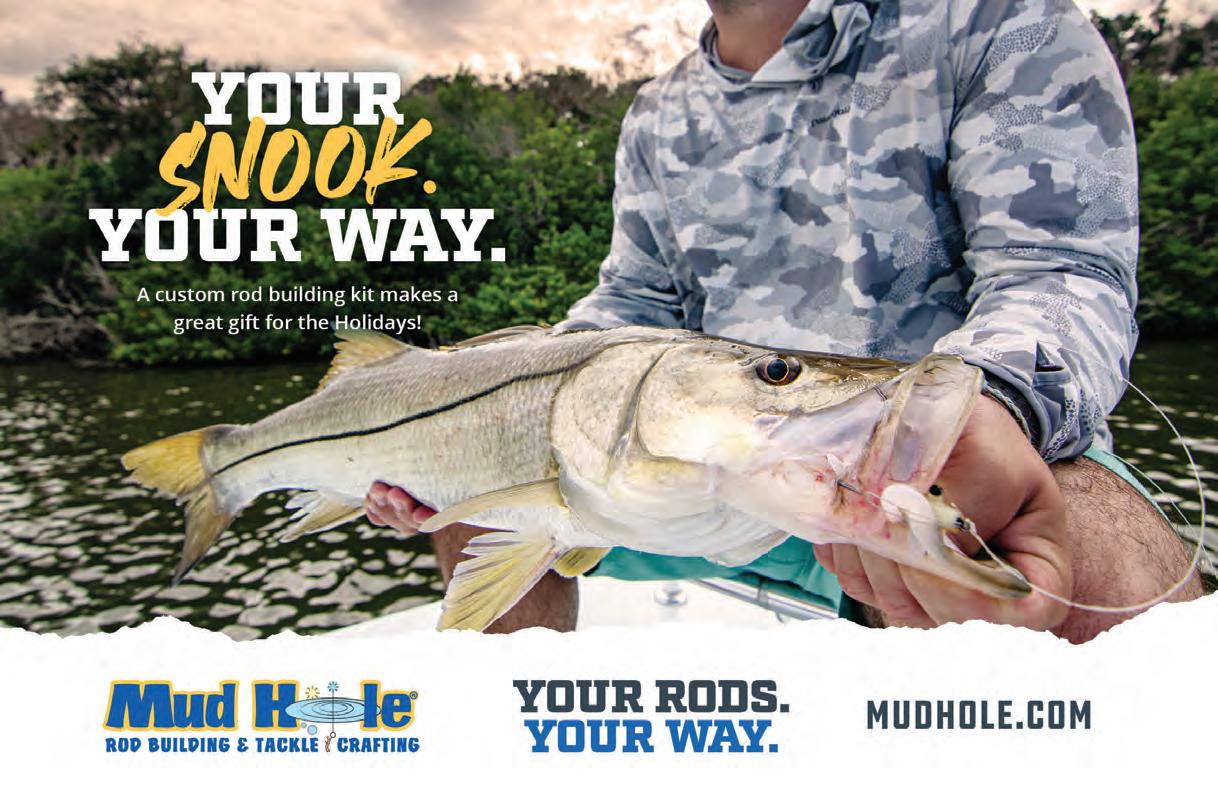

It’s not like summer, but there are still snook on the beach here on the Treasure Coast. I caught a 21-incher a few days ago in the surf and released it. My main artificial rig is a 4-inch DOA pearl white paddletail on a chartreuse 3/8-ounce DOA jighead.
Snook are looking for warmer water, so they’ll be around inlets and bridges where the water is deeper. Sometimes they run the beach because the ocean is better for them than the shallow water in the lagoon. Some large snook are being caught in deeper water of the St. Lucie, both North and South Forks, Crossroads and around deep piers and bridges as well as around deep water in both the St. Lucie and Ft. Pierce inlets. Large jigs and live or cut bait fished early morning, at dusk or at night work best. Live 6-inch croaker seem to be the preferred live bait. This month, you can harvest one snook in the 28- to 32-inch slot here in the IRL Zone.
March is windy and will be the last good month for many of the winter fish like pompano, mackerel and bluefish. Some fish, especially bluefish, will remain, but the numbers are relatively small. Pompano can be caught on the beach with orange fish bites and sand fleas. In the lagoon, try jigging from bridges with pompano jigs on moving tides. Chartreuse or hot pink are good colors. Permit have been caught on the beach on small crabs, fish bites or large sand fleas. Both permit and pompano are 50 to 70 yards offshore.
The mackerel bite is good on the beach early in the morning when bait is present. This bite is in the trough around the close breakers. Small spoons like silver 1-ounce Krocodiles or gold Johnson spoons with treble hooks work best, but they will hit any lure retrieved quickly near the surface. The mackerel are still in the Peck’s Lake area where you’ll need a boat. The bluefish bite has been sporadic with fish chasing bait in early morning or when bait is present.

Trout are scattered in the lagoon and can be caught on jigs and topwaters like Skitterwalks and Zara Spooks on warm afternoons. The best trout areas are north from the power plant to the Vero Beach flats. The flounder bite is still good on small jigs and live bait on the flats and around the bridges. Some redfish have been caught on jigs tipped with live shrimp from the power plant north. Target mangroves on high tide in the


afternoon or mangroves with deep water.
As usual, there are scattered schools of ladyfish and jacks cruising the beaches. Some nice jacks in the 5- to10-pound range have been taken on jigs and shallow-running crankbaits.
Remember, see the birds, find the bait, catch the fish!
Richard L. Matteson Jr. is a long-time Coastal Angler contributor and staff writer for Stuart Rod & Reel Club. Contact him at (336) 414-3440.



Our specialty is high-quality round rubber skirt material in tabs, perfect for creating custom lures or skirts. We also have a great selection of silicone material, at amazing prices!

SILICONE SKIRT MATERIAL
SILICONE SKIRT MATERIAL


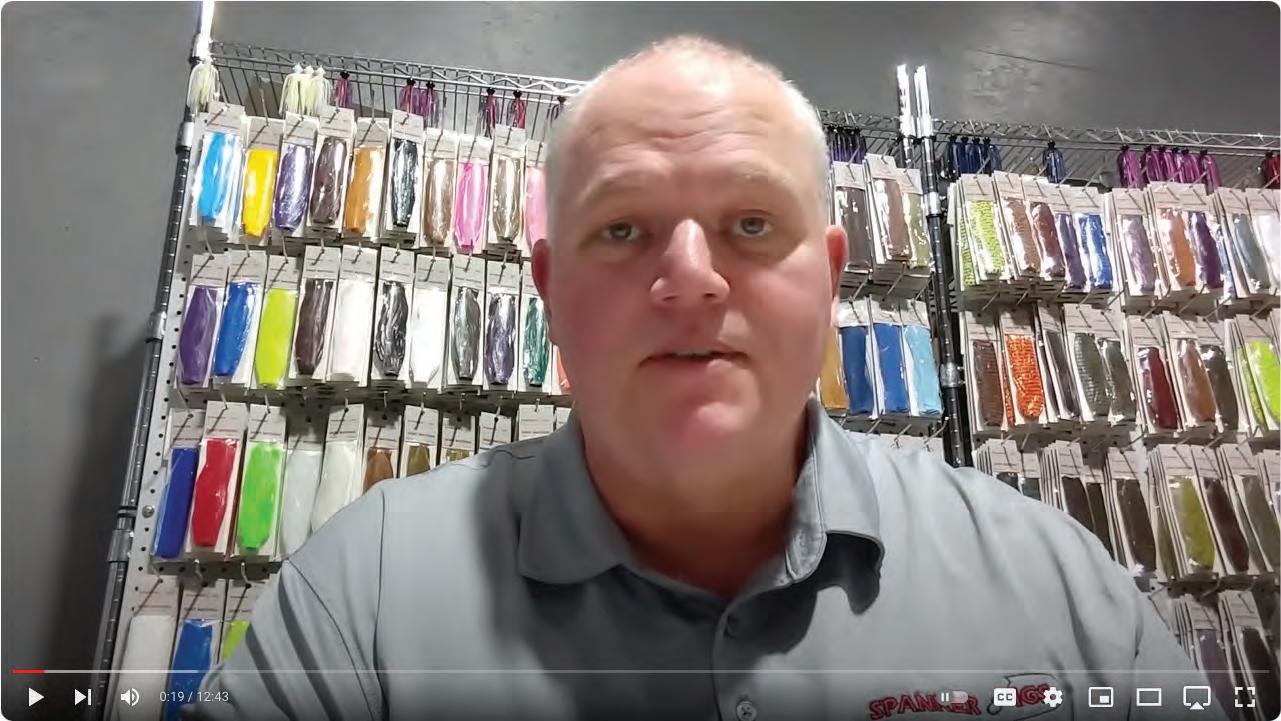
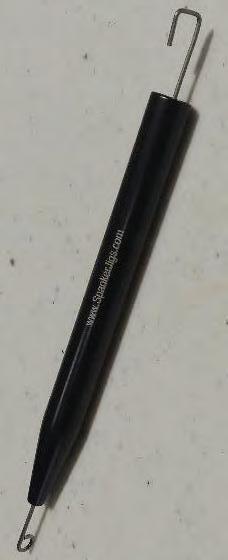






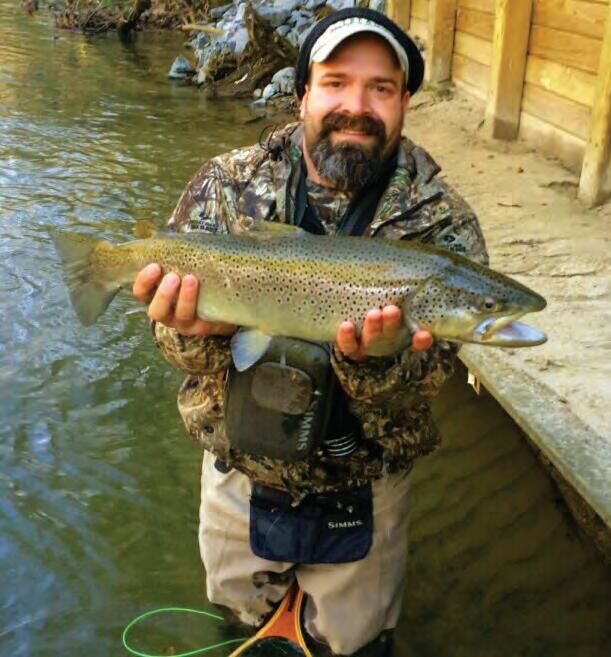 By Joe DiPietro
By Joe DiPietro
If there’s one thing I’ve learned from spending most of my life trying to think like a trout, it’s that trout don’t think like people very often. Yet, every now and again, I get lucky and get something right.
Every angler lives for days when the trout take standard fly patterns without regard, but the reality is that most days that’s not the case. That doesn’t mean you have to invent a pattern that the fish have never seen before to fool them on days when flies from the bins at the fly shop won’t. Sometimes, adjusting the size of the fly you’re fishing compared to the actual insects the fish are eating is all it takes.
I like to step up dries and step down nymphs first when trying this and then go the other direction if the first shift doesn’t inspire a bite from fish. If tinkering with fly size doesn’t produce, tweaking some small aspect of a standard pattern many times will convince the trout to take a fly.
A favorite adjustment of mine is changing a natural-looking wing case on a nymph to something odd and flashy. Sometimes just going to an odd color of flashabou is the ticket, while other times being more creative with what sort of materials are use is required. This is the case in one of my most effective pheasant tail nymph variants which includes a wing case made of gold flashabou and an abdomen made by direct dubbing gray marabou. From time to time, I’ll include legs made of the stiff barbs from a wood duck flank feather, particularly when the nymphs in the water are mottled.
Whatever aspect of a fly you’re trying to make more appealing, it’s important to stay open-minded with what materials you choose. A good example of this can be seen in my material choice with some of my rubber-legged stonefly patterns, which range from pre-fabricated rubber LivelyLegz to strands from a spinnerbait or jig designed for bass fishing. I’ve also created
a few good looking thoraxes and wing cases from individual strands of rubber from bass jigs. Another effective example of this I’ve found is replacing the abdomen of a standard hare’s ear nymph with direct-dubbed underfur from a red fox tail. The bottom line with this all is to not be afraid of trying something you’ve maybe never seen or heard of. If you haven’t seen it before, chances are good the fish haven’t either.
Sometimes you get lucky and find a technique that really works. Other times, you’re just the laughing stock of your fishing buddies. But if you never try it, you’ll never know. Keep in mind that whatever part of the fly you choose to change, it is usually best to start small. Don’t change legs and a wing case right out of the gate, try one first, then the other, then both at once.
Joe DiPietro is a Georgia-based trout guide and fly tyer. Check out North Georgia Trout Fishing at www.blueridgetroutfishing.net.




Peppertree Maggie Valley was developed in 1981 as one of the mountains premier timeshare vacation resorts. Our 40 two bedroom condos look out over the beautiful Maggie Valley Club Golf Course and beyond to the Great Smoky Mountains that surround the valley. Owners and renters (from Peppertree Maggie Valley) may enjoy the amenities of the Maggie Valley Club including golf for two people during their stay. The many area attractions are a short drive from the resort. These include the Great Smoky Mountains National Park, the Cherokee Indian Reservation, Harrah’s Casino, and America’s largest private dwelling house, the Biltmore Estate, in Asheville.
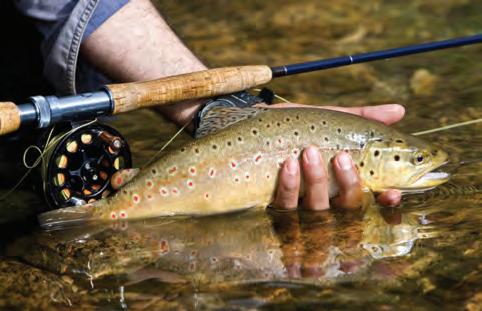
Peppertree is affiliated with both Resort Condominiums International (RCI) and Interval International (II) for any who may want to exchange in from another resort and we have rentals and some re-sales available.
A three-mile section of Jonathan Creek has been

classified as the Maggie Valley Mountain Heritage Trout Water. It is hatchery supported and is subject to restrictions that have been established by the N.C. Wildlife Resources Commission. This area provides convenient fishing opportunities to visitors of Maggie Valley. Fishing licenses can be purchased online at www.ncwildlife.org or by phone at (888) 248-6834. A 3-day license costs $11 for residents & nonresidents age 16 or older and is valid only for waters designated as Mountain Heritage Trout Waters.
The Great Smoky Mountains National Park has approximately 2,900 miles of streams and provides a great opportunity for fishing, as well. Fishing is allowed year-round from 30 minutes before official sunrise to 30 minutes after official sunset. A fishing license or permit is required from either Tennessee or North Carolina. For more information including restrictions and limits visit Fishing in Great Smoky Mountains.
www.PepperTreeMV.com


Our sister, The East Tennessee Fishing Show & Expo hosts the largest gathered selection of fishing boats, tackle, kayaks, custom lures, rods, reels, apparel, marine electronics, fishing accessories, and more! – We have taken a few pages from her playbook, and we have brought them down to Gadsden, Alabama where we will be bringing the 2nd annual Alabama Fishing Show & Expo!
We ONLY host vendors with fishing, marine, and lake/salt-life related products! Many of our vendors offer multi-species gear for fresh or salt water! We welcome any and all vendors who might have that ‘next BIG thing’!
We try to make sure there is something for every kind of fisherman that attends our event!
We are also sure to include a huge selection of boats and kayaks too, as we try to make it as easy as possible to shop for the newest salt/fresh water fishing boats, gear, and accessories from many reputable and top-notch marine dealers in the greater local and regional Alabama area.




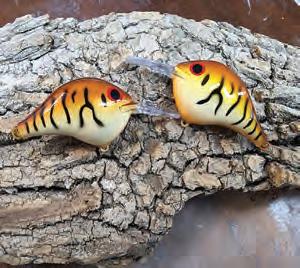




The newest in fiberglass and aluminum fishing boats, tackle, kayaks, custom lures, rods, reels, apparel, marine electronics, fishing accessories, and more! That barely gets us started.



A17-pound, 8-ounce bluefish is pending as a new Alabama state record, according to the OBA Community Website in Orange Beach Alabama.
Rustin Musgrove, fishing from the beach near Perdido Pass, caught the more than 37-inch-long bluefish on a Carolina-rigged frozen finger mullet around sunset on Jan. 26. Even after sitting on ice for 60 hours while Musgrove sought out certified scales, the fish
beat the two-decade-old existing record by 4 ounces. The existing state record weighed 17 pounds, 4 ounces and was caught by Alicia Walimaa in the summer of 2004.
According to the OBA report by David “Pierpounder” Thornton, the fish is likely to be 12 to 14 years old. At 37 inches in length, Musgrove’s fish is almost 3 inches longer than the current IGFA all tackle length record for the species. The IGFA all-tackle world record by weight was an incredible 32-pound,
12-ounce fish caught off Hatteras, N.C. in 1972.
In his article, Thornton went on to explain that while bluefish in the Atlantic regularly reach weights in the teens, a fish like that is very rare on the Gulf Coast of Alabama. He attributed this to the massive menhaden populations in the Atlantic, which feed fastgrowing and ravenous bluefish.
To read Thornton’s article, go to obawebsite.com.



Forty-nine reservoirs stretch across the Tennessee Valley like a string of pearls. And for those who love to fish, those lakes are just as valuable. Whether it’s bass, crappie, walleye, or catfish, whether for sport, food, or just fun, you can find world-class lake fishing only hours away from any spot in the Tennessee Valley. From more than 11,000 miles of shoreline or while floating on more than 700,000 acres of water, residents and visitors will quickly learn why this area is considered one of the best fishing destinations in the U.S. and, some would say, the world.
Fishing from the shore can be restful and rewarding—and anyone can do it. All you need is a little intel about how to find a spot where the fish might be biting. Here are a few tips for successful shore fishing from the Tennessee Wildlife Resources Agency:
• Fish are often swimming near the shore in the spring and fall. If you’re fishing from the shore in the heat of summer, do it in the evening or early morning—or even after dark.
• Fish near-unique features such as docks, logs, trees, rocks, or rocky areas; aquatic vegetation; or places where creeks enter the water.
• When fishing in moving water, look at the surface for boils and breaks—this means there is some underwater structure blocking the current, which could be the perfect hiding place for fish.
• Begin fishing (casting) close and parallel to the bank, then work your way outward (fan casting) toward deeper water.
• If you don’t get any bites, try switching baits. If this doesn’t work, move to another hole.
• Wear polarized sunglasses so you’ll be able to see fish as well as submerged objects more clearly. (Your eyes will also be protected from the tackle.)
If you love outdoor sports—boating, hunting, fishing—and the natural world, or if you just like to observe wildlife, build birdhouses, maintain a bird feeder or are just curious about the critters in your backyard, the Tennessee Wildlife Resources Agency is here to help enrich your outdoor experience. Visit us at www.tn.gov/twra/





Around the country, spring is either here or it is rapidly approaching. There is an amazing tip I want to share to improve your chances for catching big bass this time of year.
In spring, bass flood into shallower areas of any lake. Whether that be a bank, pocket or a flat shallow area, they move shallow to start their transition and get ready to do their thing. They use any type of readily available cover to stage up and then eventually spawn. This takes a lot of the guesswork out of the search for where your next bite may come from.
What I look for is isolated cover and structure. Types of cover that I look for differentiate from state to state and lake to lake, but the general concept is always the same. The more isolated the better!
For instance, here in Florida, anything from a couple lily pads or a very small patch of vertical grass sticking up away from most of the other cover is the ideal spot for a big one to be sitting. In other areas of the country, it could be a single rock, a piece of wood or any kind of debris or cover that looks out of place. Shallow brushpiles near a spawning area that you find with your electronics are also an awesome thing to look for.
TYLER WOOLCOTT
Some of my biggest spring bass have come from something so obvious that most anglers go right past it. Fish also often replenish on these places very quickly, so don’t overlook visiting the same piece of structure multiple times in a single day. One of my favorite things to do is cast to isolated lily pads. There could be two tiny little pads out in the middle of a flat on their own, and I might catch multiple fish off the same two pads by revisiting them throughout the day.
I often pick apart these objects by dragging something slowly by or through the structure. Typically, a wacky-rigged weightless Senko or a very lightly weighted Texas-rigged stick bait are my go-to lures. When in Southern states that have some stain to the water, I stick with darker colors like blacks and blues or junebug. When the water is clear, I’ll go with more natural colors like a green pumpkin.
You can keep your gear pretty simple, but remember you’re fishing around structure fish can wrap you around and break you off. Use heavier line. Try stepping up your leader size to 12- to 15-pound Seaguar fluorocarbon on a spinning rod, and use 15to 20-pound when throwing a Texas rig on a baitcaster. The 13 Fishing Defy series of rods
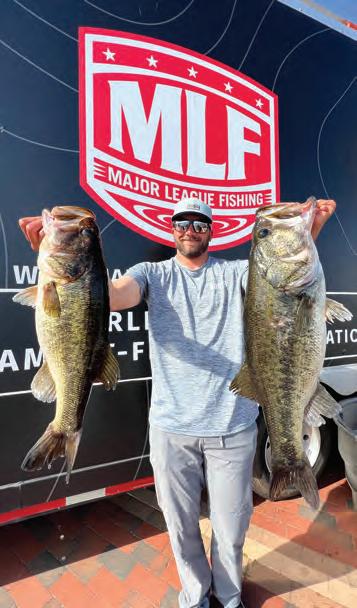
are awesome and affordable. I use the 7’6” MH for baitcasting rods and the 7’1” MH for spinning.
Good luck out there this spring and always have fun and be safe on the water.
Tyler Woolcott is a professional tournament angler and guide. Check out his website at www.tylerwoolcottfishing.com.
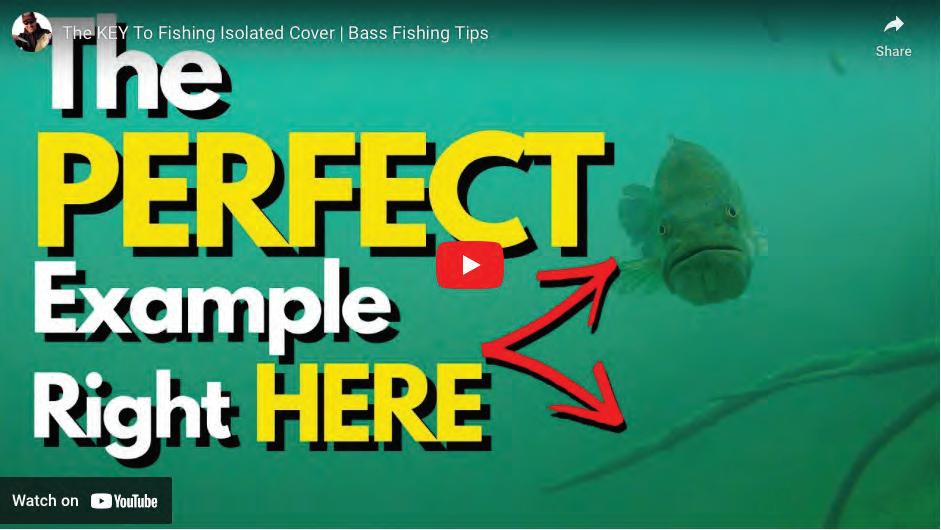


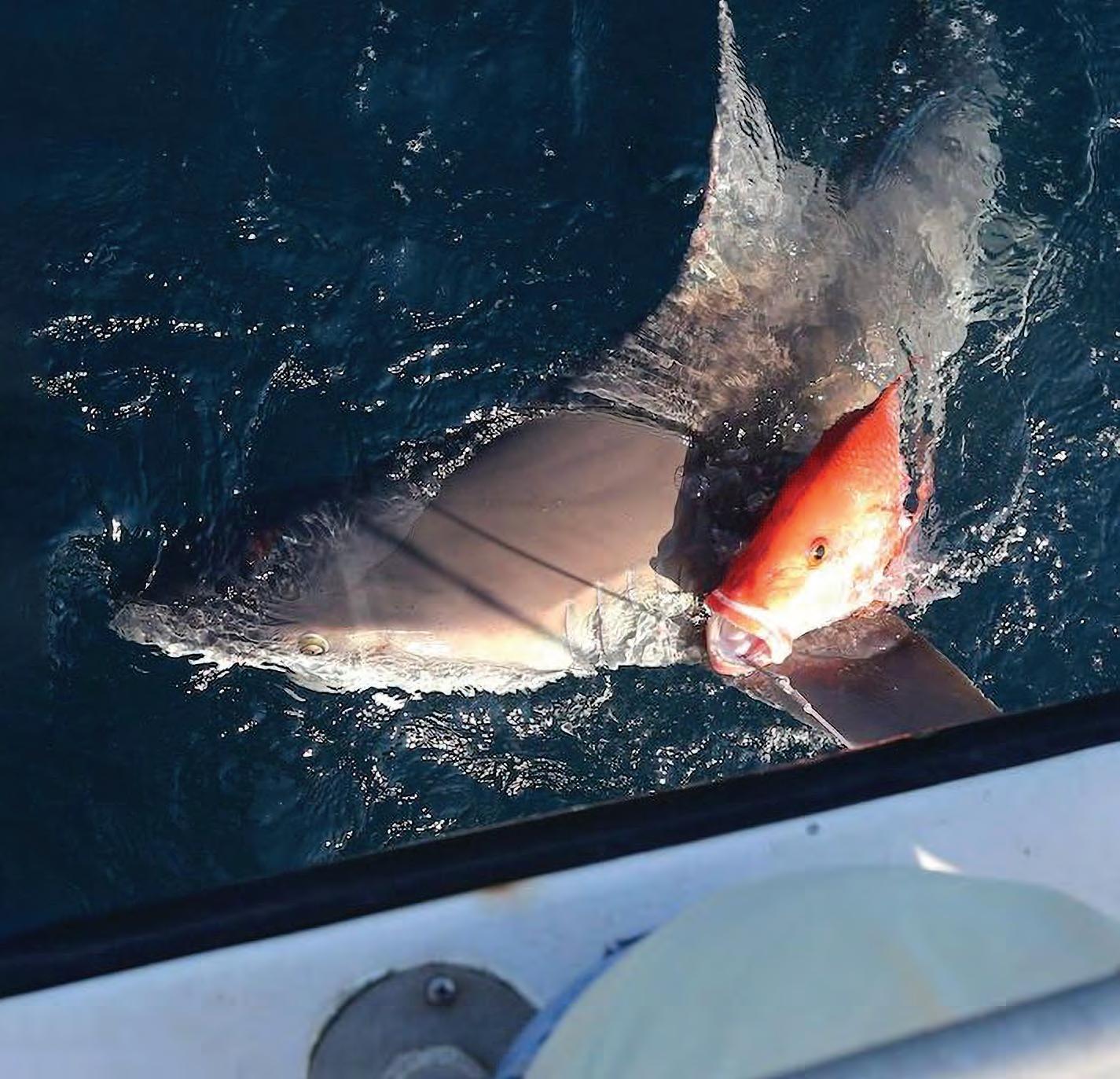
very saltwater angler knows the frustration of losing their hard-earned catch to sharks. With a hard thump, that big, feisty cobia or snapper stops fighting and all that’s left to haul over the rail is a head. Those delicious fillets were donated to the taxman, and there’s nothing you can do about it.
Well, it seems the U.S. Congress is at least willing to take a look at the issue of shark depredation, which is a shark hammering a fish on the line before it can be landed. The SHARKED Act is a piece of legislation working its way through Congress right now with bipartisan support. The bill is just a first step toward mitigating shark interactions with anglers, both recreational and commercial, but it’s one of those rare occasions when legislators
By CAM Staffmight just come together.
According to the American Sportfishing Association, shark encounters are increasing on all U.S. coasts. The Magnuson-Stevens Act of 2007—the sweeping legislation that gave us the decades-long red snapper fiasco in the Gulf of Mexico—has been successful, maybe too successful, in rebuilding populations of many shark species that were previously reduced by fishing. In addition to being frustrating to anglers, there is concern that sharks are negatively impacting fisheries, and there is already talk among fisheries managers of stricter regulations on anglers intended to
offset or avoid shark interactions.
With support from several sportfishing and conservation organizations, the SHARKED Act unanimously passed out of the U.S. House of Representatives, and at presstime it was headed to the Senate and potentially to President Biden to be signed into law. It would direct NOAA Fisheries to develop a task force to study the issue of shark depredation. The task force would be tasked with improving coordination and communication across the fisheries management community to identify research priorities and funding opportunities and make a plan to reduce shark/angler interactions.
We can only hope this future plan puts limitations on the taxman and not on anglers.







Cicadas are some of the most prevalent, yet overlooked, insect hatches for anglers. In the eyes of fish, these big droning bugs are like a bacon double cheeseburger slapped down in the middle of a tray of finger sandwiches. When a fat cicada crashes on the water with a plop, it is stuck there floundering around until something with a big enough mouth shows up to eat it. To trout, largemouths, smallmouths, spots, stripers, catfish, carp and other species, a cicada struggling on the surface is irresistible, and a large cicada hatch can bring on some incredible dry fly action.
There are some cicadas that hatch every
year, and these can be excellent for getting the bass fired up on top at your local pond on summer evenings. However, the periodic broods with long lifecycles are what get fish and fishermen excited. These big bugs spend almost their entire lives underground feeding and burrowing and emerge in two- to 17-year intervals to mate and restart the cycle. Singing their loud mating calls in the trees by the thousands, they are a deafening annoyance, but for anglers on the water these massive hatches can become the stuff of legends.
Bill Stranahan, of Hiwassee River Guides, in Reliance, Tennessee, has had his eyes on the forecast for 2024. He said there is potential for two separate broods to hatch this spring

and possibly overlap in the region.
“My prediction for the hatch will be from mid-April to May, with it tailing out in early June. This timeframe will vary some depending on April weather and temperatures,” he said. “Depending on where the hatch hits the water, we will be targeting trout on local rivers while fishing the lakes for carp and bass species. This has the potential to be some of the finest dry fly fishing of the year. April is already a great time for dry fly fishing, but with the cicada hatch, it could be the best we see all year.”
Here is some info from the website Cicada Mania to help you scout your area for a coming cicada emergence. If they are emerging, the fish will be looking for them.
• Cicadas will begin to emerge when the soil 8 inches below the ground reaches 64 degrees. A warm rain often triggers an emergence. The timing depends on the weather.
• Look for cicada chimneys,
which cicadas build from the soil above the hole where they will emerge.
• Look for holes about the diameter of an adult finger near the roots of trees. These are sure signs of a coming emergence.
• Once cicada nymphs emerge, they will climb a tree and shed their skin before stretching their wings and taking on their adult colors. You will find dried cicada husks on the trees where the adults left them.

• Fish where there are trees and overhanging vegetation cicadas use as they emerge. Cicadas do not live and lay eggs in water like aquatic insects, but they do crash land or die and fall to the water, where fish will be waiting on them.

• Fish heavier rods and tippet. Cicada flies are large and air resistant, which means you’ll need some power to throw them. Also, fish feeding on cicadas are not leader shy, and you’ll sometimes find fish fighting over cicadas.
• Don’t be shy about slapping a cicada fly down on the water with a plop. This can draw attention to your fly, and cicadas don’t settle daintily to the surface, anyway. Also, twitch it a little. Dying cicadas struggle and buzz on the water. Giving your fly some action can call in fish from a distance.
Check out Hiwassee River Guides at hiwasseeriverguides.com.

 SBy Dan Saknini
SBy Dan Saknini


hooting docks can be one of the most fun and productive techniques for crappie fishing. It is simple, but it does require some skill.
Shooting docks requires you to practice and learn several simple steps. Hold the rod with your dominant hand, with the bail open and your index finger holding the line. With your other hand, grasp the jig head, keeping your fingers away from the barb of the hook. Keeping the rod parallel to the water, pull the jig toward your body, bending the rod into the shape of a C, with the fishing line aligned with the rod. When you release the jig, it will shoot in the direction the rod is pointed.
Helpful tip to practice at home: Crack your garage door open about a foot. Stand 15 to 20 feet away from the door and practice shooting your jig under the garage door. Make sure you clip the barbs for pet safety. You can also use a 5-gallon bucket turned on its side and aim into the bucket. The more you practice, the better you’ll get.
Even when fishing stand-alone brushpiles, you will find that shooting your jig will give you more accurate placement than casting your line overhead, especially on a breezy day.


Here’s a quick redfish tip from Capt. Garrett Ross, of Miss Judy Charters out of Savannah, Ga.
“While using a traditional adjustable style cork, adjust depth to allow the live shrimp to sit directly on the bottom. This means that your cork will be laying completely over on its side. Now, when the cold-water redfish decides to take the bait in its mouth, you will not know until the cork stands up right and starts to make way. It is suggested to reel lightly tight and allow the circle hook to do its job of lip hooking your redfish!”
Capt. Garrett’s reasoning for the effectiveness of his technique is that a redfish has plenty of time to eat the shrimp and begin to swim away before the angler holding the rod even knows the fish is there. It might sound counter-intuitive, but circle hooks have a way of coming unbuttoned when there’s an over-eager angler holding the rod.
For more from Capt. Judy Helmey, visit missjudycharters.com.
 Ethan Long, 13, with a nice redfish caught while fishing with Capt. Garrett Ross.
Ethan Long, 13, with a nice redfish caught while fishing with Capt. Garrett Ross.

You don’t need an invitation to have fun in Upcountry South Carolina: Come kayak crys-tal blue lakes, hike to rushing waterfalls, dig into local cuisine, attend family oriented events and breathe fresh mountain air. But when you hold a South Carolina fishing license, it feels like an official ticket to enjoy the great outdoors.
Fish bite year-round in the lakes, rivers and streams of Upcountry South Carolina, which is located in the state’s northwest corner in the foothills of the Blue Ridge Mountains. Devils Fork State Park in Salem is a great place to access Lake Jocassee, which holds state records for rainbow trout, brown trout, redeye bass, smallmouth bass, spotted bass and yellow perch. Or try your luck at Lake Hartwell, at Lake Hartwell State Park in Fair Play and Sadlers Creek State Park in Anderson, three-time host of the Bassmaster Classic.
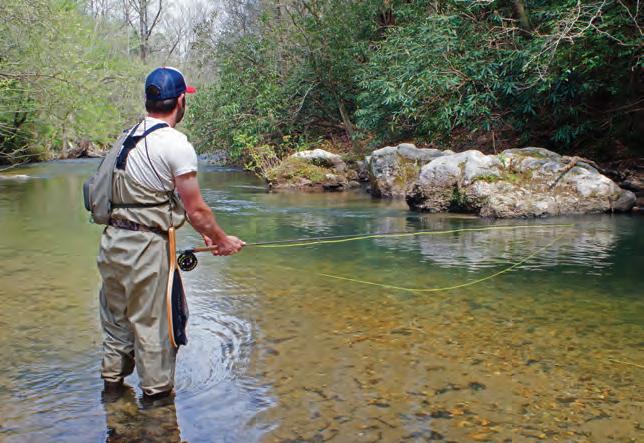

The Chattooga River boasts healthy wild trout populations and is also regularly stocked by Oconee County’s Walhalla State Fish Hatchery. The Whitewater River above Lower White-water Falls is another great option for wild trout. Lake Keowee, at Keowee-Toxaway State Park in Pickens County, swims with largemouth, smallmouth and spotted bass, crappie, bluegill, yel-low perch, catfish, brown and rainbow trout.
Pick up everything you need—including advice— at local fly shops or book a guided fish-ing trip. Sam Jones, of Jocassee Charters, puts anglers on trophy trout. Buster Green’s Guide Ser-vice reels in stripers, hybrids and bass on Hartwell and Keowee. Chattooga
River Fly Shop leads fly fishing trips on the Chattooga and Chauga rivers.
Even if you don’t fish, you can still get on the water. Jocassee Lake Tours offers tours of the lake and of Jocassee Gorges, which National Geographic called a “destination of a Lifetime.” Some amazing spots can only be reached by boat. Several tours are offered, so you can learn from a naturalist while riding on a pontoon or paddle a kayak through coves and under waterfalls.
Prefer to captain your own boat? There are several rental companies, including Tri-County Boat Rental, on Keowee, Jocassee, Hartwell and other lakes.
If you’d rather be under the water, Jocassee is a world-renowned freshwater diving desti-nation that boasts visibility of more than 50 feet at depth. Lake Jocassee Dive Shop offers lessons and guided trips to see “The Wall,” where a section of mountain was blasted to build the dam, or a 40-foot swim-through wooden sailboat.
From fishing to boating, hiking to camping, biking to bird watching and more, the Up-country’s state parks are a great place to play. Dip into the swimming hole at Oconee State Park. Hike to the tops of Pinnacle and Table Rock mountains at Table Rock State Park. Explore the 13,000-acre Mountain Bridge Wilderness Area at Caesars Head State Park. Or create your own adventure at any of the Upcountry’s 13 state parks.







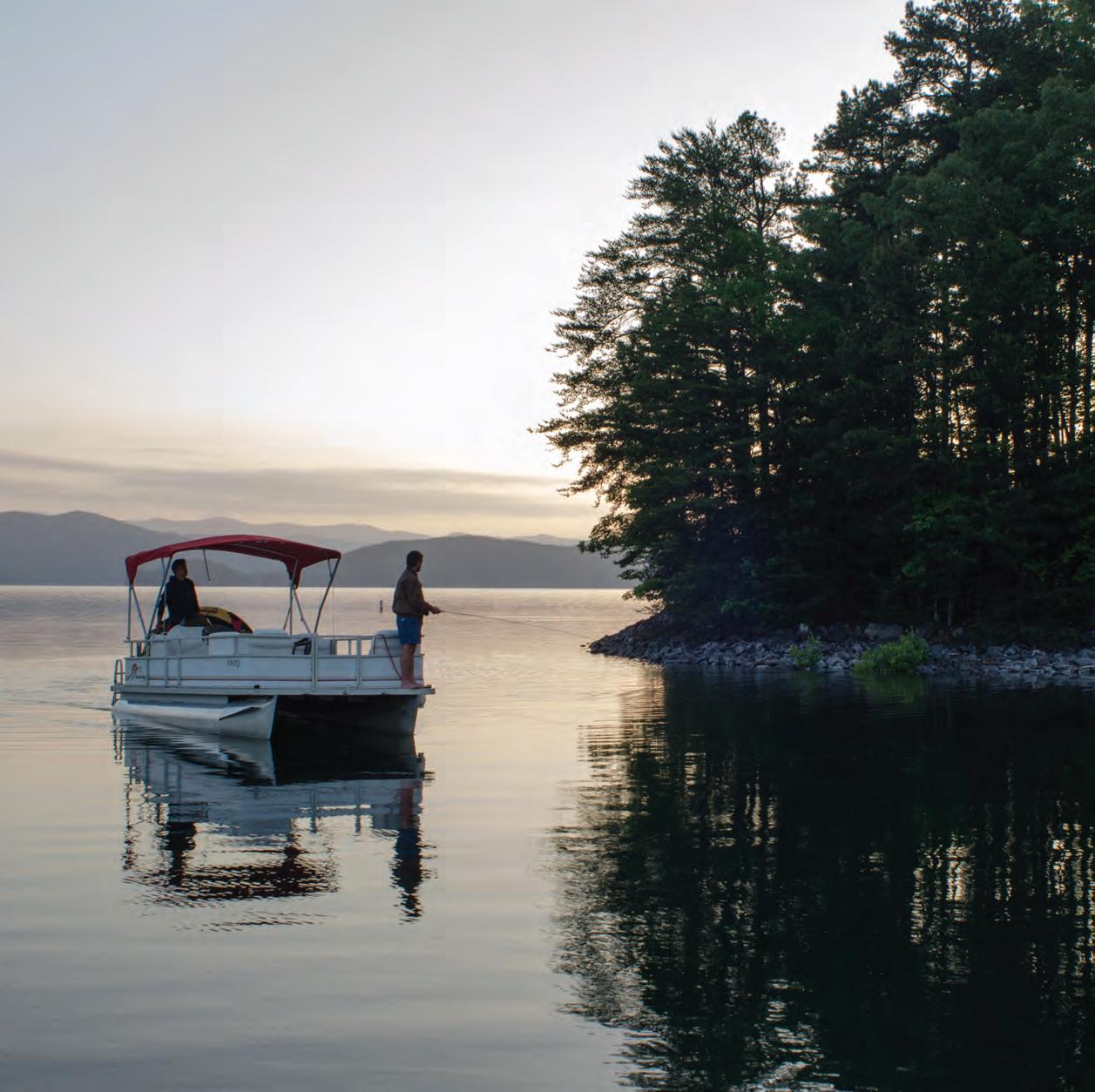






Every angler is thrilled that daylight savings time has finally arrived and we have an extra hour to fish every day. But with improving weather and extended opportunity come the crowds. Everyone seems to want to go fishing just when you do. And so comes the chaos at the boat ramp. We are certainly blessed with great access with many parks and public boat ramps, but those are largely unsupervised leaving us all at the mercy at the folks in front of you on any given day.
So let’s all agree to be thoughtful and considerate of the boaters behind us and adopt a few ground rules that every civilized boater should observe.
1. Most ramps have staging areas… a place to park and unload all the gear from your vehicle and transfer it to your vessel. Tie the ropes to the cleats, if you are going to use them
By CAM Staffto launch your vessel. All of this should be done before you get in line to launch!
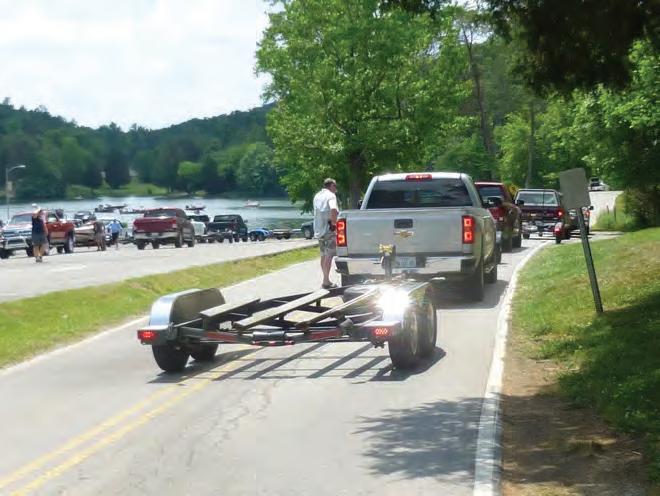
2. If you are next in line, make sure everyone has all their belongings together that they intend to take for the day and get out of the vehicle, and use the restroom if needed, so only those involved with actually launching the vessel are on the boat ramp.
3. Pull up and back down onto the ramp, as close as possible to the side of the ramp, allowing ample space for others to utilize the ramp. I’ve even pulled in the middle of two boats launching on either side of me when there is room. Launch your vessel and pull completely away from the boat ramp area. Move quickly to the appropriate parking area and secure your vehicle.
4. If you are lucky enough to have someone drive the vessel off of the trailer, take it to a
vacant dock staging area, and away from the boat ramp, to wait for the additional members of your party. If you have to walk the vessel back with ropes, move it far enough back to allow others to use the boat ramp.
5. The reverse is true when you are returning. Use the dock staging areas to unload passengers. Do not pull up to the boat ramp and block the area until your trailer arrives. If you have to get the trailer, secure the vessel in the staging area with a member of your party and fetch the trailer. Once in place you can quickly get the vessel to the trailer.
If all of us make an effort to be considerate of those behind us, we will all be smiling all the way to our favorite fishing grounds!


smaller chicken dolphins. If lures are your thing I prefer Yozuri Crystal Minnows and honestly color doesn’t matter. Pitch around the weed lines or patches and look deeper down for the bigger Mahi. As for Tuna with all the chumming going on, I like to send down a vertical jig on 60#-80# test at least 100’ below the boat. Working your jig through the water column is a good way to fire up any kind of fish that may be lurking around in the shadows. If you have a large diamond jig I’d put some heavy wire in front of it for a chance at a wahoo. Triple Tail are amazing fish on light tackle and I recommend 15#-20# fluorocarbon and #2 Owner hook. Live
If bottom fishing is your go to joy Vermillion snappers, Groupers, and Rock salmon is my target. For Vermillion snappers I like using a 2-3 hook chicken rig mixed with cut squid and Boston mackerel. Let your weight sit right on the bottom and wait for those 2-3 light bites. Rock salmon and Groupers like to hide out in the rocks and caves, so a slip lead is what I like to use. Heavier leader line for Groupers and larger baits close to the bottom. Feel the bite and start cranking. The first 20’-30’ are the most
When it comes to offshore fishing don’t give up. There’s a lot of trial and error. Figure out what works best for you and as always keep your lines out and keep them tight.









